- Daily Deals
- Brand Outlet
- Help & Contact
- Watchlist Expand Watch List Loading... Sign in to see your user information
- Recently Viewed
- Bids/Offers
- Purchase History
- Saved Searches
- Saved Sellers
- My Collection
- Expand Cart Loading... Something went wrong. View cart for details.

Picture 1 of 5
Yacht game solid wood ages 6+.
- 92.3% positive
- Seller's other items Seller's other items
- Contact seller
- Add to cart
- Add to watchlist
Oops! Looks like we're having trouble connecting to our server.
Refresh your browser window to try again.
Additional service available
Shop with confidence, item specifics, item description from the seller, seller feedback (176), more to explore :.
- Diecast Yachts ,
- Yachts Vehicles ,
- Age of Sigmar Wood Elves Games Workshop Warhammer Fantasy Chaos Games ,
- Electric RC Yachts ,
- Wooden Yachts Vehicles ,
- Hobby RC Boat & Watercraft Yachts ,
- Ice Age Trading Card Games ,
- Hobby RC Boat & Watercraft Yachts with Vintage ,
- Classic Games Wood Contemporary Chess ,
- Trademark Games Wood Contemporary Chess
Related Searches
- sailboat wooden
- games wooden
- sailing yachts for sale
- yacht inflatable
- yacht club shirt
- american yacht club
- vintage wood board games
- vintage yacht
- ocean yacht
- old wooden boats for sale
- antique board game
- jaws game board
- Search Please fill out this field.
- Give a Gift Subscription
- Manage Your Subscription
- Newsletters
- Sweepstakes
- Project Plans
- Toys and Kids Furniture Plans
Yacht Rock Balance Game Woodworking Plan
With more than 1,500 woodworking project plans, back-issue collections, project kits, and more, the WOOD® Store is your one-stop-shop for customizing your woodworking journey with the expert content from WOOD ® magazine.
Prepare your sea legs for a challenging two-player voyage. This tabletop balance game promises fun for all ages as players try to keep on an even keel, moving passengers safely from the deck to their cabin. Interchangeable rockers of differing sizes vary game playâ€"large rockers provide more stability, and smaller ones demand more finesse. Built-in storage makes the game easy to stow away or take on the go.Overall Dimensions: 22"W x 4-5/16"D x 3"HFeatured in WOOD Issue 272, December/January 2020/2021
Related Articles
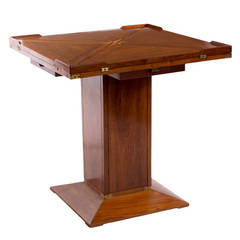
Folding French Yacht Game Table
View similar items.

- Item Details
- The 1stDibs Promise
About the Item
- Creator : Starbay (Manufacturer)
- Dimensions : Height: 29.5 in (74.93 cm) Width: 29.5 in (74.93 cm) Depth: 29.5 in (74.93 cm)
- Materials and Techniques : Inlay , Parquetry
- Place of Origin : France
- Period : Late 20th Century
- Date of Manufacture : circa 1980
- Condition : Good
- Seller Location : Salt Lake City, UT
- Reference Number : 1stDibs: LU100171255920
You May Also Like
Early 20th century sheraton game tables.
Leather, Satinwood, Walnut
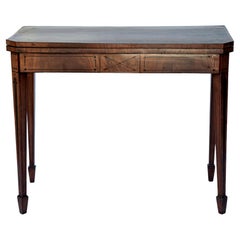
Folding Game Table
Early 20th century unknown game tables.

Inlaid Folding Game Table
Antique 1860s french game tables.
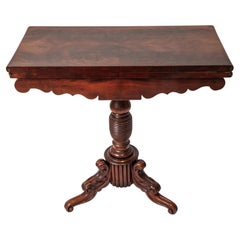
Antique game table - folding

Vintage 1950s French Louis XV Game Tables

French Louis XV Style Handkerchief Folding Game Table
Antique late 19th century european game tables.

Mahogany Fold-Over Game Table, circa 1895
Recently viewed, more ways to browse.
Yacht – Rules and Regulations of the Dice Game

- gbateson99's Blog
In the vast ocean of dice games, Yacht stands out as one of the most captivating and strategic journeys. Yacht is a game that can either be played against the computer, or online against real-life players. Either way, this game is tons of fun to play!
In this blog, we’ll go over the basic rules on how to play Yacht, as well as some strategies to help out the newer players. Continue reading to learn some of the rules that you’ll have to know in order to succeed.
Rules of The Yacht Dice Game
It can be intimidating to start playing the Yacht. Players start out by rolling five dice, with a complicated scoring sheet right next to the table. This might seem like it's going to be hard to learn. However, when you break this board game down to its core components, you will see that it isn’t so difficult to learn how to play Yacht.
Yacht starts by rolling five different dice. After each roll, you will have the opportunity to decide which dice you would like to keep and which ones you would like to re-roll. After three rolls, you must pick which combination of dice to go with.
Every time that you finish rolling, you must select a new category to put your roll under. There are tons of different categories to select from at the beginning of the game. Categories include ones through sixes (where you sum the corresponding numbers), three of a kind, four of a kind, full house, small straight, large straight, yacht (five of a kind), and chance.
Categories are broken into 2 different areas – the top part of the sheet and the bottom part. The bottom part is all of the niche categories such as small straight, three-of-a-kind, and full house. The top part of the sheet is entirely made of the ones through sixes section. If you are able to get a cumulative score of 63 with those 6 categories in the top part, then players will get a bonus of 35 points on their sheet.
Final Round
After all 13 rounds of Yacht, it is time to total up your entire score. The player with the highest amount of points wins the dice game and is declared champion.Oftentimes this will only come down to 10 or 20 points. Remember, every round counts!
Common Strategies
When going toe to toe against opponents, it can be difficult to come out victorious when you’re just starting. Not to worry though, these small tips and tricks will help to give you a leg up on the competition.
The bonus is key
As we previously mentioned, if you are able to get 63 points total in the section of ones through sixes, you will receive a 35-point bonus. This is an absolutely crucial aspect of the game. You should always make sure to try and hit this point mark, especially the fours, fives, and sixes.
Don't waste your Chance
One of the categories of the Yacht Dice Game is Chance. The Chance category allows you to add up the total of all the dice in a given roll and score that total. It is a useful category that should only be used in emergencies. When the game is nearing the end, having a safety valve is huge.
Know when to take risks
As you near the end of the game, it will become obvious how far ahead or behind you are. This should inform your decisions on how risky you want to play. You may be willing to go for the 50-point Yacht if you are far ahead, or you can play it safe and try and get some easier points in a different category. Understanding how risky you can afford to be is a crucial part of learning how to play Yacht.
So now that you have learned the basics of how to play Yacht, make sure to go and try it for yourself. Whether you want to challenge an opponent from across the world, play against the computer, or sit down and face a friendy, it’ll be a fun and competitive time.
See more Board games
Sport & leisure
Toys & games
Board games

Jumbo Hi-tower - Tumble Tower Block Stacking Game - From 0.6 to 1.5 metres
Sold & shipped by GARDEN GAMES LIMITED
Available online only and not stocked in B&Q stores
Product details
Product information.
Our Jumbo hi-tower brings the classic block stacking game to life in a supersized way. Crafted from sustainable pine wood, this set boasts 58 smooth, solid blocks that build a towering structure starting at 0.6 meters and reaching an impressive 1.56 meters in play!
Challenge friends and family of all ages to take turns carefully removing blocks without toppling the precarious tower. The last player to successfully add a block to the top wins!
Perfect for every occasion!
- Guarantee - 1 year
- Assembly not required
- Comes with Giant Hi-Tower Game and Carry Case
Features and benefits
Big Game Hunters Jumbo Hi-Tower in a Bag, Builds from 0.6 Metres up to 1.5 Metres High in Play, Garden Games Large Outdoor Tumble Tower
- Fun family game for all. Perfect for parties, BBQ’s, camping or taking to the park in the sturdy carry bag included.
- The 58 solid pine blocks build a tower starting at 0.6m high, reaching 1.5m (max.) in play for giant fun.
- Blocks stack in the same way as the traditional table top game, making it easy to set up and ideal for children
- Sourced from sustainable forests, each block measures 15cm x 5cm x 3cm giving a stable footprint of 15cm x 15cm
- Packed in a strong nylon carry bag with zip close and fabric handles for storage and portability
- Indoor or outdoor fun - enjoy backyard barbecues, family gatherings, or park outings with this versatile game.
- All ages welcome, from toddlers to adults, jumbo hi-tower provides hours of entertainment and friendly competition.
- Easy storage and portability. The included sturdy canvas carry bag with a zip closure and handles makes storage and transport a breeze.
Specifications
| Brand | Big Game Hunters |
|---|---|
| Colour | Wooden |
| Location for use | Garden |
| Material | Wood |
| Pack quantity | 1 |
| Product height | 1500mm |
| Product width | 150mm |
| Product weight | 7kg |
| Product code | 5035874506131 |
How to Play Yacht Dice Game
The complete rules for the dice game yacht
Erik Arneson is a highly respected board game expert, sharing his 20 years of knowledge on gaming strategies. He's the author of the book, "17 Games You Can Play Right Now," has been a featured speaker at the American International Toy Fair, and is the former Vice President of the Strategy Gaming Society.
Yacht is the public domain dice game upon which the published games Yahtzee and Kismet are both based. Here's how to play.
The Basics of Yacht
1 or more players. Best with 2 to 5 players.
5 six-sided dice , along with pencil and paper to keep score.
To score more points than your opponents by rolling certain combinations of numbers.
Create a score sheet with 12 rows and a column for each player. Label the rows as follows:
- Large Straight
- Small Straight
- Four of a Kind
- Player's Choice
Definitions
- Yacht: Five of the same number (e.g. 4-4-4-4-4).
- Large Straight: Five in a row starting with 6 (i.e. 6-5-4-3-2).
- Small Straight: Five in a row starting with 5 (i.e. 5-4-3-2-1).
- Four of a Kind: Four of the same number (e.g. 5-4-4-4-4).
- Full House: Three of one number, two of a different number (e.g. 4-4-4-1-1).
- Player's Choice: Any combination of dice.
- Sixes: Only sixes count for scoring.
- Fives: Only fives count for scoring.
- Fours: Only fours count for scoring.
- Threes: Only threes count for scoring.
- Twos: Only twos count for scoring.
- Ones: Only ones count for scoring.
How to Play
A turn starts with a player rolling all five dice. The player may then set aside any number of dice, rerolling the others, or he may stop rolling and proceed to scoring. It is legal for a player to reroll all five dice. It is also legal to reroll dice previously set aside.
On each turn, a player has a maximum of three rolls. After a third roll, the player must stop rolling and proceed to scoring.
Each player will have 12 turns during the game. After each turn, the player must enter a score in one of the rows on the score sheet.
Example: Ana rolls a 1-2-2-4-6. For her second roll, she decides to keep the 2s and reroll the other three dice. She rolls 4-4-6, so she now has 2-2-4-4-6. She has already scored a Full House, so for her third roll, she decides to keep the 4s and reroll the other three dice. She rolls 1-4-4 and now has 1-4-4-4-4. She decides to score for Four of a Kind.
It is likely that a player will make a roll that does not qualify to earn points in any of the remaining categories. In this case, the player must mark a "0" in one of the available categories.
Yacht Scoring and Values
- Yacht: 50 points. (It does not matter what numbers are on the dice.)
- Large Straight: 30 points.
- Small Straight: 30 points.
- Four of a Kind: Up to 30 points. (Add the point values on all five dice, so 4-4-4-4-1 would score 17 points. It is legal to use five of a kind for this category, so 6-6-6-6-6 would score 30 points.)
- Full House: Up to 28 points. (Add the point values on all five dice, so 3-3-3-6-6 would score 21 points. To earn points for a full house, the three of a kind must be different than the pair.)
- Player's Choice: Up to 30 points. (This serves as a "wild card." Simply add the point values on all five dice.)
- Sixes: Up to 30 points. (Add the point values of all sixes rolled.)
- Fives: Up to 25 points. (Add the point values of all fives rolled.)
- Fours: Up to 20 points. (Add the point values of all fours rolled.)
- Threes: Up to 15 points. (Add the point values of all threes rolled.)
- Twos: Up to 10 points. (Add the point values of all twos rolled.)
- Ones: Up to 5 points. (Add the point values of all ones rolled.)
Winning Yacht
After every player has scored in each category, the players each total their scores. The player with the highest score wins.
More from The Spruce Crafts
Solid Wooden Boat Model Kits
Products of solid wooden boat model kits.
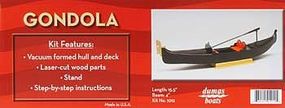
| Add To Cart | Wish List |
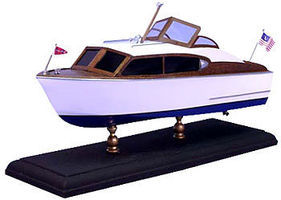
1956 24' Sedan Kit
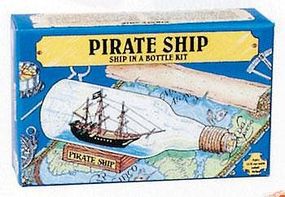
Pirate Ship in a Bottle Kit
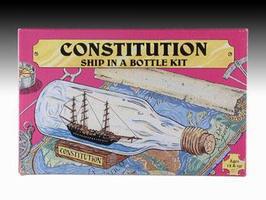
Ship in Bottle Constitution Kit

12'' Sailboat Junior Kit
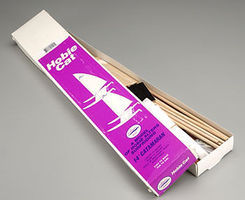
Hobie Cat 14 Kit
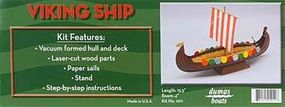
Viking Ship
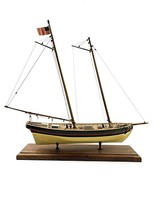
KATY of NORFOLK 1-48 ##
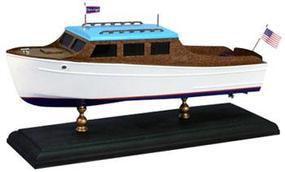
12-1/2'' 1935 Chris Craft 25' Steamline Cruiser Laser Cut Kit
| Pre-Order | Wish List |
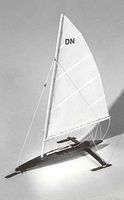
18-3/4'' DN Ice Boat Kit
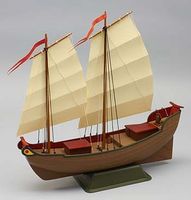
Chinese Junk Boat
Refine search, filters (3), hull (1 of 2) clear.
Attainable Adventure Cruising
The Offshore Voyaging Reference Site

- Hull Materials, Which Is Best?

As Phyllis and I think about what our next boat might look like, one of the primary decisions is hull material.
We have several chapters in this Online Book about the characteristics of the four general available options, steel, aluminum, wood and fibreglass (see Further Reading below), but that still leaves the question: Which is best, not just for Phyllis and me, but for you, too?
As usual, the answer is the oh so annoying: it depends on what we plan to do with the boat.
But what I can say, is that there are two materials that are pretty easy for Phyllis and me to drop from the hull materials prospect list. So let’s start with that, and then move on to the two left standing to pick a winner.
Hull Material We Won’t Consider
We will not even be looking at boats made of steel or wood—not quite true, we might consider a good wood epoxy saturation build—and that’s also our advice to most of you.
Why neither of those two materials? Both are intrinsically unstable. Or, to put it another way, no matter how well the boat is built, if left to their own devices, wood will rot and steel will turn into a pile of iron oxide.
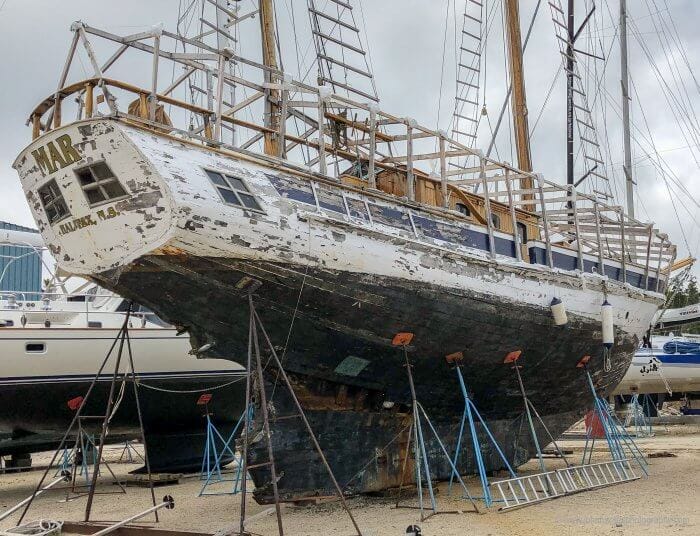
OK, before you take me to the woodshed in the comments, let me make clear that I understand that good boats can be built of both wood and steel.

One of my good friends has a wooden boat that has given great service (including a bunch of ocean crossings) for decades, and will continue to do so for many more. But he built her himself, has cared for her meticulously, and has incredible skills. But I’m not Wilson (that’s his name) and, in all likelihood, neither are you.
The same applies to steel. If you built the boat yourself, or supervised every step of the build, and then cared for her yourself, it can work. Just look at the amazing voyages made by AAC contributor Trevor Robertson in Iron Bark .
But we are talking about second-hand boats for most of us, so steel and wood are out because it’s difficult to be reasonably sure in a pre-purchase survey on either material that something horrible is not going on deep within the structure. Something that, when discovered, can turn our new-to-us boat into a worthless pile of junk—we are talking the risk of serious wealth destruction here.
Still not convinced? Let’s dig deeper.

There’s another big problem with wood. If we find say a rotten stern post, or any other structural member after purchase, the skills and time to replace it are prodigious. Heck, just replacing a single plank in a way that will actually be watertight takes great skill and perseverance. Way beyond practical DIY for most of us. And I have seen professional replacement of just a few rotten members in a wooden boat cost over US$100,000.
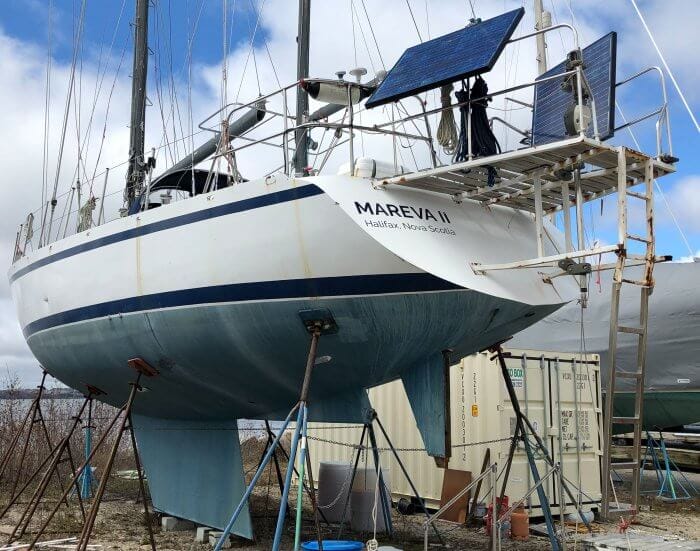
What about steel? Well, on the positive side, repairs require less skill than wood. But the problem is it is very difficult to build a boat of steel under about 45 to 50 feet that will sail or motor well. The reason is that steel plating must be of a certain minimum thickness to be workable and not deform, regardless of boat size, so small steel boats are pretty much always too heavy, at least for the performance that Phyllis and I want.
And, finally, the maintenance of a steel boat is simply no fun—unless you have some perverted love of chipping rust and working with toxic chemicals—and to make that worse, any breach of the coating must be dealt with promptly and properly.
The bottom line is that I know a lot of people who own a steel boat, or have done so in the past, but I have never met anyone who has owned a second steel boat.
All that said, I guess purchasing a steel or wood boat with a history like those I mention above, from someone you really trust, would be OK—particularly if you make clear that if they have lied to you, you will hunt them down and… And the advantage of this course is that you can often get a lot of boat for very little money.
Hull Materials We Will Consider
Where does that leave Phyllis and me, and probably you, too? Yup, with fibreglass and aluminum. Both are intrinsically stable—assuming we don’t do something stupid, and, when built right, a hull of either does not deteriorate just because of the passage of time.
And both can be surveyed prior to purchase to make fairly sure (there is no certainty) that there is not something horrible lurking. Yes, I know there are many horror stories (I have one of my own) about fibreglass boats with hidden faults, but that’s a survey failure, not a material one. (More on how to avoid survey failures coming soon.)
So which is best, aluminum or fibreglass? Brace yourself. I’m going to do it to you again. It depends on what you want to do. Let’s look at each.

As a 30 year aluminum boat owner, I love the material. And if Phyllis and I were planning to go to seriously hazardous places (as we have in the past), aluminum would be our only choice.
But on the other hand, aluminum is a bitch to keep paint on, an expensive bitch. And, by the way, don’t think for a moment that leaving the hull bare solves that. Prepping and painting the deck and cabin of an aluminum boat to the yacht standard that many owners want and want to maintain, will, if done right by professionals, cost as much or more than painting an entire fibreglass boat.
The point being that if you are considering aluminum, you need to do as I do: take your glasses off when you see the paint bubbling. Or, better yet, seriously embrace the industrial look and have no paint on deck or hull, other than non-skid.
Also, although there is no question that most of the horror stories you hear about aluminum are just that—stories—the material does require caring for, including closely supervising anyone who works on the boat. Most boatyard professionals are dangerously ignorant about aluminum and many will make that worse by not appreciating their own ignorance.

So that leaves fibreglass. And for Phyllis and me, who now want a boat that we can safely leave unattended far from home—we are now part-time cruisers—that’s the way to go.
Also, as we age further, we will be paying boatyards to do more and more for us, another plus for fibreglass, since it’s more resistant to unsupervised ignorance—boats with core in the hull, particularly balsa, not so much—than aluminum.
Bottom line, if you are not willing to learn the basics of aluminum boat care and won’t be constantly present to rigorously enforce that knowledge on others, choose fibreglass. On the other hand, the good news is that said aluminum boat care is not hard, and not magic. See Further Reading for our complete guide.
I’m guessing that many of you steel boat owners are now seething and reaching for your keyboards to tear me a new one. Feel free to disagree and tell me why steel is great, but be realistic.
And please keep in mind that we have a lot of readers who do not have a lot of boat ownership experience. So if you blow sunshine about the issues with steel boats, particularly old steel boats, you may make yourself feel better, but you may also tip someone into a life altering decision with substantial negative consequences. Not something any of us need on our conscience.
Further Reading
- How to care for an aluminum boat in 27 easy steps.
- Much more on buying a boat .
- How to care for a cruising boat, once you have bought her.
- The engineering characteristics of hull materials.
- Impact resistance and why it matters .
- More on boats from Boreal .
- More on Ovnis .
Please Share a Link:
More Articles From Online Book: How To Buy a Cruising Boat:
- The Right Way to Buy a Boat…And The Wrong Way
- Is It a Need or a Want?
- Buying a Boat—A Different Way To Think About Price
- Buying a Cruising Boat—Five Tips for The Half-Assed Option
- Are Refits Worth It?
- Buying a Boat—Never Say Never
- Selecting The Right Hull Form
- Five Ways That Bad Boats Happen
- How Weight Affects Boat Performance and Motion Comfort
- Easily Driven Boats Are Better
- 12 Tips To Avoid Ruining Our Easily Driven Sailboat
- Learn From The Designers
- You May Need a Bigger Boat Than You Think
- Sail Area: Overlap, Multihulls, And Racing Rules
- 8 Tips For a Great Cruising Boat Interior Arrangement
- Of Cockpits, Wheelhouses And Engine Rooms
- Offshore Sailboat Keel Types
- Cockpits—Part 1, Safe and Seamanlike
- Cockpits—Part 2, Visibility and Ergonomics
- Offshore Sailboat Winches, Selection and Positioning
- Choosing a Cruising Boat—Shelter
- Choosing A Cruising Boat—Shade and Ventilation
- Pitfalls to Avoid When Buying a New Voyaging Boat
- Cyclical Loading: Why Offshore Sailing Is So Hard On A Boat
- Cycle Loading—8 Tips for Boat and Gear Purchases
- Characteristics of Boat Building Materials
- Impact Resistance—How Hull Materials Respond to Impacts
- Impact Resistance—Two Collision Scenarios
- The Five Things We Need to Check When Buying a Boat
- Six Warnings About Buying Fibreglass Boats
- Buying a Fibreglass Boat—Hiring a Surveyor and Managing the Survey
- What We Need to Know About Moisture Meters and Wet Fibreglass Laminate
- US$30,000 Starter Cruiser—Part 2, The Boat We Bought
- Q&A, What’s the Maximum Sailboat Size For a Couple?
- At What Age should You Stop Sailing And Buy a Motorboat?
- A Motorsailer For Offshore Voyaging?
- The Two Biggest Lies Yacht Brokers Tell
What are the hull and deck panel thicknesses on MC?
As I remember, hull 1/4 to 3/8 in the keel. deck 3/16″. That said just looking at plate thickness does not tell you a lot. For example MC is built with very closely spaced frames and stringers which add a lot of strength but less weight than heavier plate and fewer frames and stringers.
John, I hear your warnings about steel, and I know this might be a complicated route to go. My main reservations about fiberglass boats is that the majority of them come with external keels which is fine for me for a one or two weeks charter but something I absolutely do not want for my own future boat. Encapsulated keel structure (or welded on as with steel hulls), a deep V forefoot, and a rugged skegged rudder, are characteristics that can more often be found with steel hulls as with “plastics”. When going for my survey I plan to come with a fiber optic to inspect all those remote places, and would certainly rule out a boat where I would not have access to most if not all hull places. That said, if I were to buy now, my current favourite on the market is a fiberglass ketch 😉
I would not recommend discarding all external keel boats from your list. Yes, the modern trend to bolting through light skins and then using a glued in web to stiffen things up is intrinsically dangerous, but there are plenty of external ballast boats that are built properly.
And internal ballast is not without problems. Like with most things it all depends on the execution.
And there are good hull forms in GRP too. In fact, in my experience, a lot of steel boats are designed very poorly.
Anyway, I would not take on the risk and maintenance burden of a second hand steel boat for those reasons.
Agree with everything you say about steel boats. When I got back from Vietnam in 1969, I took all of my savings and bought a steel 45 steel schooner and lived on her. I went to work at the Naval base in Pensacola, FL and left my wife to chip, sand and paint the rust spots that seemingly appeared almost every day inside and outside ( no wonder she divorced me! ) I finally sold the boat to a “know it all” and bought a Hinckley 50 fiberglass yawl — problem solved!
Hi Patrick,
Thanks for the report. Another person who has owned one steel boat!
I totally agree with your conclusions on this. No material is perfect but fiberglass has a lot to be said for it overall and aluminum is great when a bit extra is required. Aluminum is actually the only material you have listed that I really don’t have much experience with beyond little skiffs so it is the one I can’t properly comment on but I like the concept.
I have had a lot of interactions with wooden boats including having a good sized one in the family and working aboard several. While I love these boats and think they look great, our boat is fiberglass and that is intentional. For that matter, our boat doesn’t have any wood on deck at all. With wooden boats, like most things, it really comes down to who the owner is. An owner who gets it and stays ahead of maintenance puts in surprisingly little time (still a whole lot) dealing with rot and paint that won’t stick. An owner who is a little less vigilant and deals with a deck leak by hanging a diaper under it rather than getting out their irons to fix it will find the boat falls apart on them incredibly quickly. In my experience which is all salt water based, deck leaks are the biggest killer of these boats by far and they are actually comparably one of the easiest to track down and fix. Even for an owner who farms out the wood work, I would say that if you can’t fix a deck leak and don’t have oodles of money, then it is a disaster waiting to happen.
With steel boats, all I have to say is that I hate the sound of a needle scaler. If you have a ton of money, there are great examples like the Columbia replica but that is not attainable for most of us.
I realize that there are a lot of people who get very nervous with keel bolts (and bolts in general in anchors and other things) and while it is something to watch, I think that it is a good trade-off given the other options. I think that a lot of the issue is that the average person does not know how to evaluate whether a bolted connection is a good connection and there have been an awful lot of poor connections built over the years. An example of a good connection is most connecting rod bolts which have enormous numbers of cycles, vibration and other factors to contend with but yet basically never fail unless there is another underlying issue such as the caps being mixed up. By getting the bolt stretch length long enough, using appropriate materials, having appropriate mating threads and using enough torque/tension, you end up with bolts that don’t back out and do not fatigue. Keels are a bit tricky as very few materials won’t suffer from some sort of corrosion if there is any water and fiberglass creeps so it is difficult to maintain constant tension but I think that you would find an extremely low failure rate on well designed connections and that most of the failures were on connections where an analysis would have shown that the margins were low and best design practices were not followed.
On wooden boats, although I have little first hand experience, as you say, and I see demonstrated by Wilson, a skilled and diligent wooden boat owner can make the maintenance look easy, but let a wooden boat get away from you and there will be tears.
On keel bolts, a question for you? If contemplating buying an old boat with external ballast, would it make sense to insist that before purchase the keel bolts (assuming accessibility) were torqued to the proper value for their material and size?
My thinking is that, assuming the construction and bolts were right when built, the biggest risk, particularly with SS bolts, is that they have wasted at the keel to deck joint due to water ingress, so if they withstand the appropriate torque without breaking we can be pretty sure that that they are not appreciably weakened. Does that make sense?
I would make no such assumption about the keel bolts. They may be seized, in which case you’ll see the correct reading on the torque wrench but the pre-load tension in the bolt will be wrong. They may also be partially corroded, in which case they may withstand the torque but still be capable of failing in tension if the boat were to, for example, ground on a reef.
If it’s possible to get at them to check their torque, it shouldn’t take much longer to completely remove the nuts, one at a time, to check the studs or the cavities for signs of corrosion before re-torquing them to the proper specs. If it’s not possible to do this, then it’ll be difficult for *any* non-destructive examination to reveal what you want to see.
Thanks for coming up on that. How about just loosening a half turn and then torquing to spec? What I’m trying to come up with here is a way to at least check for a really bad keel boat situation in a way that will be acceptable before purchase, and I fear that if we try and actually remove the nuts and backer plates the seller will reject the idea—just torquing the bolts is going to be a hard enough sell.
So, I get that the bolts may still be a long way from original after this test, but at least it will catch the ones that have corroded really badly. Also, I’m not sure that removing the nuts would tell us much since the bad bolts I have seen were corroded where the keel meets the hull, but would have looked fine from above, even with the nuts off.
Bottom line, I get that this is not a great solution, but my thinking is that it’s practical and a lot better than nothing. Would you agree?
Pull a few and inspect is probably the only real way to to be sure. At least this is done on a woodenboat.
Ignoring whether a seller will or should allow retorquing keel bolts, the theory is good but the practice is somewhat more problematic. Proof testing is a well established industry practice that has proven to be pretty effective. Periodic hydrotesting of pressure vessels such as boilers, tanks, etc is just one example of something that has been successful at eliminating a lot of dangerous failures.
The first practical issue is what torque do you apply. I design capital equipment not sailboats so don’t know exactly what is done as there are multiple schools of thought but if I were designing one of these joints, I would figure out my worst case loads, choose a preload of ~2X and then upsize the bolts from there a bunch to give a corrosion allowance but not increase the preload any more. The question is, what was done on the boat you are looking at. The average person does not have the knowledge to calculate what the maximum per bolt load is and then we don’t know the factors from there. I suspect that there are some boats out there where the torque value from the factory is 75% of yield just like most bolts are but I also suspect there are a lot of boats out there where the preload will be more on the order of 30% (I have it written down at home but I believe this is approximately what I calculated for ours with the assumptions I made). In the case where the designer did not leave a corrosion allowance, then a torque to 75% of yield is entirely appropriate but on other boats, you could break a bolt which while corroded was actually still well within allowable parameters or you could crush the laminate if there is insufficient load distribution for the higher tension. All of this can be calculated with fairly simple calculations but having anybody without training apply it is problematic and even then, you are really doing a proof test not just a retorque as you likely won’t know the original torque. If anyone knows of a standard that all designers hold to so a way to avoid the guessing game of the factory torque, I would love to know it.
The other practical issue that comes to mind is the imperfect relationship between torque and tension. Engineers refer to this relationship as K factor which is basically friction between the threads and the faces. When tension is really critical, the standard thing to do is to actually use oil or grease which are more repeatable and represent a lower K factor. If there has been any galling at all which is a real problem with stainless, all bets are off and you could even break the bolts before bottoming out if it is really bad. This is really the long way of saying that it is really inexact if you do it dry, you would really want to clean everything well and then oil the threads. Of course, if you are NASA, then you can actually measure tension on the bolts but everyone else is left using torque as a proxy.
Given all of this, I am not sure that most sellers could be made to agree to a specific torque number unless original build documentation can be found with a number which I don’t think that I have ever seen (unfortunate and kind of scary). Retorquing is definitely not a bad idea and I have done it on our boat, I just don’t know how to implement it simply and quickly unless someone knows that all keel bolts were originally torqued to some % of yield or something equivalent.
Hi Eric (and Matt),
Thanks for going to all the trouble to explain that. As so often happens, I’m a lot wiser after reading your and Matts thoughts. And clearly my idea is not a good one.
The sad part about that is that I think those of us considering an older boat may have a real problem that’s not generally recognized: Having wandered around boat yards a lot lately, I’m seeing a lot of otherwise good looking boats with stains indicating that water has penetrated between the keel and hull. I’m also guessing that a lot of boats for sale have had those stains covered up with paint.
Add in that many of those boats will have stainless steel keel bolts and I’m starting to think that the only good answer with a boat like that is going to be to drop the keel to check the bolts before heading offshore.
Of course we will not be allowed to do that before purchase, so that leaves walking away from a lot of good boats, or assume the risk. And the risk is not trivial. If the bolts are bad, replacement can be a serious matter. One experienced person at a quality builder said that the best and least expensive solution is to recast the keel with new bolts! The point being that most keels have J bolts cast in, and he said that hacking them out is a disaster—he has seen it tried.
So the more I think about this, the more I think that a lot of people who think they have refitted their boat for sea may in fact be sitting on a pretty nasty problem that would be hugely expensive to fix. And that as the years go by, this is only going to get worse. (A lot like the problems with SS in old rudders.)
I would really appreciate any other ideas of how to deal with this, or alternatively reassurance that I’m overthinking this. Also, do you think bronze keel bolts relieve at least some of this worry? With SS all I can think about is those bolts sitting in a wet oxygen deprived environment for 30-40 years! How about industrial x-ray? Expensive, I imagine, but probably a hell of a lot less than a keel bolt replacement.
John, you just elaborated very wisely the reasons why I will certainly not be looking for a boat with an external keel. You just can’t look inside (and I doubt even industrial xray could reliably see cast-in bolts). It is just like playing lottery, and what I learnt is at least that I will never win 😉 You’re right that encapsulated ballasts have their own issues, but at least they cannot fall off during a passage.
Your call, but what I’m finding is that there are so few really good boats out there for sale that even come close to my critical needs that to settle on a single keel construction type would limit my choices. This is particularly true since I want a boat with good performance, which is harder to do with an encapsulated keel, particularly in GRP.
Also, a boat with a bad encapsulated keel can be really bad. Think steel punchings in concrete. If that lot gets cooking and splits the outer sheath (I have seen 3 of these in the last month while wandering around boat yards) the repair would be way harder than new keel bolts. Just think about jack hammering out all that stuff!
Point being there are good boats built both ways, ditto bad boats.
Just to clarify, I was not asking about X-raying the bolts inside the lead. The problems I have seen are wasting in the hull to keel joint and a bit above. Seems like X-rays would pass through the GRP and show the bolt, but then again I have no clue, which is why I asked the engineers. As I remember Matt has worked on medical imaging equipment, so we may easily get a good answer.
Hi John, Your question highlights for me that another valid comparison (apart from hull material) might be long run production boats vs short run / custom boats. Long run production yachts of course favour fibreglass of course and tend to have more than a few things worked out over time – one of which is to make them as “charter friendly” (aka idiot proof), as possible. But am I right in my supposition that for this reason, most long run production boats will have steel keels, secured with stainless bolts tapped down into the metal keel? And short run designs (not generally being for charter markets) take advantage of the performance gain with lead keels, but have studs penetrating up through the hull, with securing nuts? Reading between the lines of Matt and Erics’ responses, it seems you must remove the keel to really check the studs on a lead keel and even then there could be something lurking deeper inside. Conversely, to check the keel bolts in a steel keel yacht, you could simply specify removing say 25% of the bolts at pre-purchase survey time. For total peace-of-mind, replacing all the keel bolts on our Beneteau 473 with original OEM bolts costs about $200 US, available ex-stock from the Beneteau Spares web-site (as are most other parts by the way, even now 15 years since launch). Now I get there are pro’s and cons of lead vs steel keels. But the simplicity and integrity of a steel keel is really hard to beat. I know of a Beneteau 473 that hit a rock doing 8-9 knots under motor, coming to a crash stop. The only damage the surveyor could find on the Monday (up on the hard) was a fleck of anti-foul chipped off. No gap in the hull joint, no weeping at the keel / hull join, no cracking in the anti-foul. Internally, no damage to the lay up or the supporting girders either. No harm, no foul as they say in America. So how about a long run production boat, John? br. Rob ps – no, it wasn’t our B473!
That’s a good point although I do wonder about the actual practicality of unscrewing a keel bolt that’s been imbedded in steel for years without it shearing off. I guess it would depend on how well the original builder had treated the bolt threads with an anti-seize of some type. As usual, we are at the mercy of the builder’s QC since one small mistake in construction can lead to a world of hurt 20 years later.
And good to hear that a Beneteau withstood a grounding so well. However, I would not want the impression left that this is always the case with boats from Beneteau since at least some of their later boats are built with a keel construction technique that is fundamentally dangerous, particularly after a grounding: https://www.morganscloud.com/2014/06/05/cheeki-rafiki-tragedy-time-for-changes/
I also need to point out that if the boat in question was built using the same methods as “Cheeki Rafike” there is no practical way to know for sure that she was not damaged.
(Both are conclusions from the report on “Cheeki Rafike” and engineering done my the Wolfson Unit at Southampton University. https://www.morganscloud.com/2015/06/25/cheeki-rafiki-report-misses-an-opportunity-to-make-boats-safer/
All that said, I have no problem with the idea of a production boat and have thought about several. In fact, as you say, there are a lot of advantages to one, particularly later in the series when the bugs have been worked out.
I think you could get pretty good contrast and detail of a set of keel bolts in cross-section via X-ray, given sufficiently high quality X-ray equipment. And if the X-ray crew has access to a megavoltage source like Co-60, you’ll be able to see the bolts cast into the lead quite clearly.
This is not going to be cheap, however. And whether it tells you anything useful will really depend on the exact design of that particular boat.
You could try ultrasound, but that’s highly dependent on the technician’s skill and on the access situation for that hull.
If stainless steel, or galvanized mild steel, bolts are cast into the keel (forming studs that protrude into the boat), and there’s evidence of water intrusion, then I think dropping the keel a few inches is the only reliable way to tell the extent of damage.
With lead keels, bronze bolts are definitely the correct choice; the bronze/lead combination is basically indestructible for more than the life of the hull.
Galvanized mild steel bolts with a cast iron keel also seem to be OK as long as the bolts are accessible for periodic replacement, and I’d definitely undo one or two to check during pre-purchase survey. Stainless makes me nervous. Bronze bolts with a cast-iron keel make me nervous.
Don Casey has a good article on assessing keel joint issues here: https://www.sailmagazine.com/diy/how-secure-is-your-keel
Thanks for that great information. Sounds like there’s nothing for it but to plan to drop the keel unless it’s bronze bolts into lead. Good to know what the reality is.
Thanks for linking to that article. I’m way better informed after reading it. Casey is the real deal.
Thanks for posting link to Don Casey’s article.
I was worried what you would ask what to do about it. Unfortunately, I don’t have great ideas beyond actually taking a look. I work on the design side of things and so don’t know a lot about non-destructive testing other than where I need to make allowances for it to be done (this is something that is definitely not done in the design of these joints). My experience with X-ray is limited to inspection of welds and castings and I am not sure how it would work on keel bolts so I can’t really add anything beyond what Matt said. I believe that there are also design solutions to make this a much smaller concern that could involve changing materials, designing to be inspectable, designing to be repairable (iron keels that are tapped and bolted from the top being an example), etc but that doesn’t deal with the already built boats.
In my case, there are a few things that made me feel comfortable with our boat. Looking at the ISAF statistics compiled in 2013, of 72 recorded keel failures, only 3 could be attributed to the bolts (important to note that 40 were undefined so the actual number could well be higher). Weld failures, and internal structure failures both had a more than double incidence ratio. I actually find this failure rate pretty low given the number of poorly designed (or designed with low margin for racing), poorly maintained and poorly repaired joints out there. Our boat has a pretty conservative keel attachment, the lever arm is small and the attachment is wide in both directions and the bolts are large. Given that, I calculated the required bolt strength and then looked at the bolt size on our boat and concluded that the designer had been appropriately conservative in upsizing to allow for corrosion. Next, our boat did not show any of the problem signs such as large rust streaks, signs of grounding damage, etc. Finally, I did exactly the test that you were hoping to do which is a torque test on all of these bolts (note, this and all the calculations were done post purchase) to values I calculated and felt comfortable with. Obviously this is not perfect but has mitigated the risk to a level where I feel there are other more important places to put my efforts.
Actually pulling the keel in a properly equipped yard is not that big of a deal, often on the order of what people spend on electronics for the boat. What becomes really problematic is if the bolts are found to be compromised to the point where they must be replaced. Given our location, I would contact Mars Metals if I ever got to this point. For people who do not live near a facility like this, it gets more tricky. I have limited experience installing bolts from the bottom of a keel and I could see it working in some instances but not all.
Thanks very much for expanding on that. Obviously it’s disappointing not to have a generally applicable risk reduction strategy. But then again, when did that every happen around boats!
The good thing is that I now understand the issues and how to reduce the risk to acceptable levels. One thing I would say is that I would need to think long and hard before buying a boat that say had tankage or mast step structure over the keel bolts since that can make the job of dropping the keel from, as you say, comparatively simple, to a much bigger job.
Hi John, thought I should address the keel questions for anyone considering a Beneteau cruiser and reading this. Cheeki Rafiki, was a Beneteau First designed primarily as a racer / cruiser. They have light hulls and rely on a structural liner for much of their hull rigidity, with bulkheads and “furniture” glued in. In the main, the boats are fit for purpose and they don’t have a history of losing their keels, even though there seems to be a serious question over the keel to hull design. I personally wouldn’t sail one offshore but would have no hesitation in owning one around the NZ coast, if I raced more.
The Beneteau Oceanis 473 was designed by Beneteau as their offshore model and as I have heard it told, the model was built to help alter their “bendy Beneteau” reputation. The Clipper Oceanis range (of which the 473 is one), are the last of the all hand laid fibreglass models before European regs changed to enforce epoxy, vacuum bagging and sandwich construction. The hulls were built super-thick of solid glass fibre and more so around the keels and other high stress areas. 473s then have massive supporting girders glassed into the bottom of the hull. The bulkheads are also glassed in not glued. The flanges of these girders are wide to improve the hull bonding and spread the keel load. Around the front and back of the keel area, the girders are only about 250 mm apart. The keel bolts go through both the girder flanges and the hull. Unlike the First, the 473 in particular has a much wider keel base and a double row of bolts (single row on the First). Comparing the two boats for offshore use, is like comparing a Toyota MR2 with a Toyota Land Cruiser – built for two very different things. My experience with owning a Beneteau is the QA processes were (are?) excellent, but I must add inspecting one or two bolts a year to my maintenance list. I haven’t so far because we run a dry bilge and the bolts are like new. And John, therein lies an opportunity for an astute buyer – there are gems in most production yacht manufacturer’s ranges, just as there are bad’uns. It is finding those good’uns that can pay off – the 473 is an absolute diamond. best regards Rob
Good to hear that the 473 has the bolts through the flanges and the grid glassed in. The key to the Cheeki Rafiki disaster is that she and her sisters had neither. Also, the report stated that other boats of her class had keel problems.
I wonder what Beneteau is doing these days with their newer boats.
Also it’s important to realize that Beneteau sold the class that Cheeki Rafiki was a member of as ocean capable. They make the same assertion for most of their current offerings.
Summary: any buyer needs to check to make sure the keel support structures are glassed in (not just glued) and that the bolts pass though the flanges, not just the hull skin. If they find this is not the case, run a mile.
And anyone considering buying any modern boat with a fin keel should read the Cheeki Rafiki report so at to know what to look for.
One more thought. Sorry to be such a pain in the ass on this. But one thing I have learned over the years running this site is that people skim (particularly the comments) not read carefully. They also tend the hear what they want to hear.
The point being that while I fully understand that you are not saying all Beneteaus have safe keels, just yours, I still need to jump in with the realities from the report.
Hi John, Why do sailboat keels smile? Because they are thinking about how much fun it would be to swim freely in the ocean like the dolphins, free of the heavy burden on their backs!
Of course we all know that GRP is forever. Even after you scrap the damn thing it’ll still be recognizable land fill or artificial reef for the next thousand years. Still there is one other material that deserve a passing derisive remark: Concrete. It’s a material used exclusively by amateur builders that never seems to survive the first owner.
Insurance company do not underwrite concrete boats in Canada. Not sure of USA. Since they need civil responsibility, place are limited for an owner. Altough it was a most decent material, well insulated, cheap, partially insulated.
Yes, we have friends with a concrete boat that has served them well. That said, I decided to leave the material out since good concrete boats are pretty rare.
For what it’s worth Joe Adams (the designer of our boat) had his first big success with the original Helsal that was a ferrocement boat. It smashed up records for the Sydney Hobart classic and was forever known as the ‘Flying Footpath’.
http://rolexsydneyhobart.com/news/2012/pre-race/helsal-tribute-to-joe-adams-in-rolex-sydney-hobart/
What a great name!
Ask any physicist about the stability of Aluminum alloy and they will say ; the aluminum stability derive from its oxyde layer which is the strongest material on earth after diamond. Thus any object built of aluminum alloy should make sure that oxyde layer is preserved. A simple piece of wood on an aluminum plate staying outside in the rain will get holed in a few months and will prove you that it can be attacked easily once the Al2O3 layer is depleted in oxygen poor environment. And aluminum is born of electricity and can be destroyed by electricity.
The ebook should have started with the french joke: Circumnavigators knows that 50 % of the boat going around the world have a metal hull, the remaining are US boats.
Each aluminum boat is a unique closed loop battery and had to be kept under cathodic state under all conditions. Some boat well builts have it naturally, some others don’t and with maintenance mistakes, this is were horror stories come from.
I am not found of polyester boats because the environnmental cost of getting rid of those tons of plastic polluants at the end of life have never been taken into consideration is the first price. Polyesther fiberglass is not recyclable. We are just pushing the problem forward to the next generations. One day not to far someone will wake up and put environnemental cost on the new GRP production boat and people will realise its not cheap.
Wood as said before, is only up to the maintenance made. My marina neighbor has a magnificient wood boat that he built himself, on the plan of Joshua. He told me last weekend, 6000 to built and 6000 hours to maintain since 30 years. A tribute to those brave men.
Steel… if only the genius of the french architects who recommended to build hulls in steel and the deck and infrastructure in stainless would have been more commonly communicated, we would have less steel boats relics today. 95 % of the paint maintenance of a steel boat is on the deck. A steel hull/stainless deck has about 1 hour of touch up maintenance every year (for all those logs and obstacles hit on the water)
Thus for metallic boats ultimately the material is not the problem, its the way it has been put together and maintained. A production aluminum sailboat could be the perfect boat for circumnavigators. For some specific usage, only steel can survive. This special boat is quite an achievement, almost 20 years in the polar sea: https://vagabond.fr/en/vagabond/
(Of course i am biased i have a year of mechanical engineering classes in material resistance and my full welding certification for both Aluminum alloys, Steel and 304 and 316 stainless on conventional SMAW and also on GMAW and GTAW.)
My experience over nearly 30 years is that the aluminium alloys used in boat building are a lot more durable than you indicate. For example my boat had teak decks and toe rails for the first 12 years of her life. And, despite the fact that water had got under the teak in many places and been there for years, we found only a little surface corrosion of no consequence when we removed the wood.
Yes, as I said in the article, it’s important to follow the rules with aluminium, but that’s far from rocket science and occasional mistakes do not result in a wrecked boat in a few weeks, as many will tell you.
Also the horror stories of wrecked aluminium boats are in my experience pretty much all of the “my cousin has a friend who knew someone who…” variety rather than reality. In fact I have yet to see an aluminium boat trashed by corrosion of any type and I have seen a bunch that have been horribly neglected.
I think the key point in all of this is that marine grade aluminium is far more durable that the grades most people have experience with in other uses.
And it’s also worth keeping in mind that aluminium has a higher strength to weight ratio than steel, so in fact a stronger boat can be built in aluminium on a practical bases. That said, aluminium is not as abrasion resistant as steel.
As to the environmental issues with GRP, I hear you but I don’t think it’s that simple. For example steel boats use a lot of really nasty coatings and insulation. Also those coatings must be renewed at a regular basis. And the making of both steel and aluminium plate have a pretty big environmental impact. Point being, it would take an in-depth study taking all these factors into account to determine which, over the life of the boat, inflicted the most environmental harm.
Hi John at the marina were my boat is (Québec city) we had to get rid of an old 30 feet fiberglass sailboat unused and leftover. The city environmental personnel came in and said we could not use the city garbage service and it had to be destroyed on site and buried in a special area (city owned) for about 100$ per ton. It ended up costing us 2000$ to get rid of this boat. If it would have been alu or steel people would have paid to pick it up.
If course Quebec is very serious with garbage and landfill management and not all jurisdictions are equal. But the trend has started here…
As for alu alloy indeed 5083 is a magic material if properly maintain. I did own a 34 feet powerboat for 6 years in my auxiliary coast guard previous life and there was a corrosion meter on the dash of it (silver anode isolated under water connected to the hull) and the owner book went to great lengths explaining the potential issue. At sea no problems because electrolytic voltage are low. But I had a AC current leak from the battery charger once and I noticed a month later(boat in water) tiny droplets of water appearing at the inside of the hull in the engine room just over the propeller. I wiped it everyday and when I hauled the boat out it could be seen from outside that the aluminum was severely pitted at 3 places… almost 1/8 depth. I had to replace and reweld the plate… it was full of tiny holes. I had magnesium anodes on the boat ant they were untouched. So it was galvanic corrosion at its worst. One season…
I agree it’s a worst case scenario but I was a first line witness of it. In this case the corrosion meter didn’t showed any problem although a problem was occurring.
Do you have a corrosion meter on MC?
This being said I would not be nervous of having another aluminum boat built of marine grade alloy by professionals- it’s is certainly the best boat material if properly built and maintained.
The meter you you had would not have warned you about that particular problem. Also, my guess is that the boat was not fitted with an isolation transformer, which is absolutely required for any aluminium boat plugged into shore power.
For a complete guide to aluminium boat ownership, including a gauge that would have warned you immediately about the current leak, see the links under further reading.
Having a strong electronic/electrical background like John, I’d like to reinforce his point on isolation transformers. It’s my view they should be mandatory on all metal boats, and considered highly desirable on all others. They serve at least three safety critical purposes:
1. The obvious one is that they isolate the ground loop to the shore power ground. Essential to prevent electrolysis and ensuring swimmer safety.
2. They provide inherent shore power reverse polarity protection. This is often an overlooked and not very well understood benefit.
3. The secondary of the transformer effectively becomes a ‘local power source’ and the neutral bonded to the boat hull ground. This provides a rock solid ground path for the boat that is independent of the shore power ground. This is essential to ensure any Earth Leakage/Residual Current Balance protection devices will work reliably. Depending on a shore ground loop that may have multiple cables and connectors, all subject to corrosion and miswiring, is a hidden and underestimated danger.
While the first attribute is highly relevant to metal boats, the second and third are common to all. Probably most boats don’t have an isolation transformer, and if they all were beautifully wired to a high standard it’s a compromise I’d be more sanguine about. But isolation transformers aren’t expensive in the wider scheme of things, and from an electrical perspective I regard them as the single most valuable investment you can make.
I agree. I would never own a metal boat without an isolation transformer, and would even seriously consider one for a GRP boat.
Hi John indeed it didn’t had an insulation transformer, and i took care of installing a Victron one on my steel sailboat. The anodes barely work on my boat i have the same since 2011 🙂
Andre, GRP is recycled in Europe and on an industrial scale. Additionally GRP boats are deposited in land fill, cut up, as it is considered inert. In the UK land fill sites are now sealed for future reclamation as well as the avoidance of leaching. Regarding recycling, it is not commercial for smaller batches but tends to be the waste streams from large GRP users. Alastair
Thanks Alastair for the information, Europe is in advance on us ! Indeed fiberglass is most inert … but 10 000 years later we don’t know… probably it would still be there !
You have [predictably] left out Ferro Cement – order should be (I owned a Ferro Cement yacht for many years so speak from experience)
Fibreglass Ferro Cement Aluminium
Although I have friends with a very good ferro cement boat I did not put it in because there are so few good FC boats available. Also, to say FC is “better” than aluminium is to ignore each materials characteristics. For example aluminium has a much higher strength to weight ratio and is far more ductile.
As my wife reminds me every time I look at a “beautiful” steel boat: “Rust never sleeps”
Donald that is also true for everything apart gold, platinum,titanium and a few other incorruptible elements.
We human live in the bottom of an air ocean and the O2 is a powerful oxydant. By chance is it diluted in nitrogen because otherwise we would have all burned including everything around.
Oh and that brings a point. A steel and férocement boat would survive a fire but others not. GRP is like a gallon of gasoline waiting for its match…
One of the secrets to a good life: marry a wise spouse.
I’ve had three steel cruising boats, two of which I’ve cruised extensively with. Each were bought used, 20 or more years after they were built. If I was in the market for another boat, I’d definitely consider a steel one.
Everything depends on how the boat was built and maintained.
My current steel boat was built very well, with no longitudinals to trap water, and–more importantly–flame-sprayed with zinc inside and out (properly-prepped & applied epoxy coatings can be almost as good as this). Rust is not a problem with this boat.
Yes, there are poorly built and/or maintained steel boats that will require a lot of work to go sailing (and may not be worth restoring). I think that holds true for any hull material–a couple of years ago I was offered a once-beautiful boat, professionally-built of fibreglass, effectively for free. I turned the offer down. The boat had been neglected, and while the solid fibreglass hull was undamaged, the plywood bulkheads and most of the interior had rotted due to water sitting inside the boat (it was left unattended in a boatyard for a few years).
A steel boat with: * properly-applied coatings, * easy access to most areas (to all areas would be best, but realistically, you’re unlikely to remove tanks to inspect the plating under them unless you suspect a problem), * few or no areas where water can sit, shouldn’t be a maintenance problem.
Everyone I’ve met with a stainless steel deck, as Andre mentioned above, has had good things to say about them (none of my boats had stainless steel decks, so I don’t speak from personal experience, here).
It is true (and important) that damaging the coating on a steel boat requires fixing it promptly (how promptly depends on temperature–corrosion happens very slowly below freezing). Zinc coatings on the steel have some advantage here (if underwater), as the zinc migrates to the bared area electrolyticly, but this is only for small scratches. POR-15 (buy some small cans before leaving North America, as it isn’t all that widely available), a coating developed for the antique car restoration market (which deals with thinner steel plate), makes maintenance painting of damaged areas much easier, since it doesn’t require sandblasting before applying.
>This is the reason that by far the majority of experienced high latitude sailors have aluminum boats. Are you sure of that? When I went thru the NW Passage, there were more steel boats than aluminum boats. In Antarctica, I don’t recall aluminum boats outnumbering steel boats. In Patagonia, I saw more fibreglass boats, and roughly equal numbers of steel and aluminum ones.
Steel probably isn’t suitable for you, because you are looking at buying a considerably smaller boat than the one you have. But for someone looking to cruise long distances, high latitudes and remote places, a used steel boat could be a good choice. It all depends on the construction and maintenance that has been done, and that’s something that mostly can be determined before buying.
Best regards, Richard
Hi Richard,
Thanks for a great report from someone who clearly knows. Clearly you are the exception to the second steel boat crack I made!
As to my assertion about high latitude sailors. No, I don’t know for sure, although it has been my experience, but of course that’s not definitive. One thing I have noticed is that several high latitude sailors with substantial steel experience ended up with aluminium. Skip Novak and Hamish Laird are two that come to mind.
One thing I would say is that I would have no worries about you buying another steel boat, but I don’t think that alters my concern about buyers without your experience taking one on.
Yes, two professional, high-latitude sailors, Skip Novak & Hamish Laird have moved to aluminum charter boats after extensive experience with steel ones. I think most people who own steel boats would consider or have considered aluminum boats.
I don’t think there is any definitive list of boat types that are out doing high-latitude cruising. Records are kept of vessels that go through the NW Passage. I did a quick search of the sailboats that went through the NW Passage in 2017. I counted 4 of aluminum, 4 of steel, 3 of fibreglass, 2 of wood, and 8 that I was unable to determine the construction of. Of the two sailboats that went thru in 2018, one was ferrocement, and I don’t know about the other one. The NW Passage is very much a high-latitude trip, and anyone who has gone through it has at least that much high-latitude experience (and, I would greatly hope, a lot more experience than that before they attempt it!). Those NW Passage numbers are pretty recent, and are in accordance with what I have observed while cruising. So I respectfully disagree with the statement, which the article puts in bold print, ‘by far the majority of experienced high latitude sailors have aluminum boats’.
Some people considering a metal boat will find themselves in the situation of feeling they can afford to buy a steel one, but can’t afford to buy an aluminum one, and see their choice being to own a steel boat or not own a boat. I would encourage people considering a steel boat to read books about them (‘Steel Away’ and Tom Colvin’s ‘Steel Boatbuilding’ were both of much use to me when I was a beginner), talk to people who’ve owned steel boats, and talk to boatbuilders, yards and surveyors that work with them. I don’t know of any particular site on the internet to recommend for information on steel boats.
I agree that steel boats are not for everyone, but disagree that they are only suitable for those who have owned them before–steel boats can be learned about.
I agree, a hard to define stat. I should have written something like “most of the high latitude boats I have encountered are aluminium” or some such.
That said, I still think that steel is a tough material to own, particularly for those new to boat ownership.
I changed the line in the post. Thanks.
Thanks, now we’re in agreement.
Jut some musings.
There is an aluminium boat from 1936 still floating around and the oldest aluminium boat builder started building aluminium hulls in 1898, Savage Aluminium Boats. I think there are GRP hulls from the early ’50s still pottering about today.
I read that a typical, modern 40’ish GRP yacht has around £5000 worth of materials to make it. Today we see new and old GRP yachts sailing around the globe frequently, managing the stresses and strains of the Souther Ocean and plenty of arctic and antarctic voyages. A colleague ran his Contessa 34 onto a boulder lee shore, F5, big damage, the boat dragged off and significant repairs; owner of a Sigma 41 ran into a rock and snapped the steel toe of the hull flange from the keel all theta through, as well as significant hull damage, I too rammed a ledge at spring tides at speed and busted GRP stringers etc, none of these yachts sank. One thing that GRP has going for it, is that it flexes considerably on impact before it yields, although the area will have been significantly stressed and weakened. The same for aluminium, recently at Ardfern Marina, a modern aluminium yacht was on the hard, after the owner ran her over rocks and bashed the hull significantly at the turn of the bilge, I guess the aluminium though would have maintained a lot of it’s strength. The skills were not available to fix and she was being prepared for road transport back to the builders yard in France when I saw the boat; GRP on the other hand can be fixed easier, I suggest. The point I wish to make, is that GRP is a strong material, it has resilience and a history of surviving neglect and abuse. This is what makes it a superior material in my opinion. Sailing is a minority pastime, the vast majority of participants will have reasonable funding and GRP has proved to be very cost effective and allowed some fantastic low cost, extreme voyages to be made by amateurs. I don’t particularly value steel or aluminium for their strength in hull choice as avoiding the sort of impacts that damage hulls should be the name of the game for any serious voyager. If one is in a situation that impact damage is happening, then it is luck that is stopping the hull from foundering. I think hull design with collision bulkheads and water tight compartments is more relevant for security against foundering than GRP v aluminium v steel. It is this sort of design feature that buys time and allows options to be worked. There are always exceptions of course.
John, I think your reasons for going GRP are very valid. I am a lazy hull cleaner, preferring to let the waves do the washing. But about every 3 years I polish and wax the hull and it comes up beautifully.
Hi Alastair,
Lot’s of interesting points. One thing I differ a bit on is GRP repair. Yes, you can repair a GRP boat easily, but, and it’s a big but, it’s very difficult to be sure that said repair is properly bonded, at least without using epoxy, which has its own difficulties. Secondary bonding is a far bigger problem is generally recognized. More in a future post.
Also, metal boats have another advantage, other than just strength, and that is it’s much easier to make them stiff, and that in turn makes it much easier to make them watertight for the long haul.
And finally, strength is very important in the high latitudes where, no matter how careful, sooner or later we will hit something, either ice or an uncharted rock.
In summary, having owned both for long periods, I don’t think that GRP is “better” than aluminium, just better for my needs going forward.
We chose steel because we saw the boat we purchased had been prepared properly and we were aware of the need for prompt maintenance. Everything in “adventure cruising” being a compromise, the key to happiness is, we feel, this awareness. We are a few weeks from leaving on what we hope will be a five-year circ with an emphasis on independence from the shore and the ability to do our own repairs save for major refitting. Few people get to do this, irrespective of hull material. The wisdom of our choice will soon reveal itself, one way or another. Now, if you’ll excuse me, I have to wire up a fridge compressor…
Hi John, A few vignettes;
Steel: Bernard Moitesser’s Joshua; Washed ashore in a hurricane in Cabo San Lucas– filled with sand. Given away to two guys walking on the beach. Pumped out and motorsailed all the way up to the Pacific Northwest where she became a dock mate to my Cape George 36. Every fiberglass boat that washed ashore on the same beach was cut up and hauled away.
Brewer Atlantic 45: Built by a well know Canadian yard. Sailed around the world and arrived in Trinidad with several overlaid hull patches. Spent a year being “completely” re-plated and re-decked while sitting outside as is the practice there. (and rusting all over again) Repainted and looked “smooth as glass.” Sold to a naive young couple who panicked the first time they hoisted sail. I was offered it for $15,000 and turned it down.
Classic 110 ft. Feadship In our yard for a complete restoration. Hull built with overlapping strakes — every overlap rusted out. Re-plated the majority of the hull, re-powered and restored interior to new. Fixable, but at tremendous cost.
John Guzzwell was one of the earliest pioneers of cold molded wood boat construction. I met him when he hauled his Laurent Giles ketch out in our interior storage area. It was built in the days before epoxy— he used resorcinal glue just like the Spruce Goose. Planking was mahogany rather than the more rot resistant Alaskan cedar. And the hull sheathing was Dynel in polyester resin. John spent the winter removing the old sheathing and replacing it with glass cloth and epoxy out of concern over moisture penetration from the resin. I made it a point to chat frequently to pick John’s brain and learn everything possible about cold molding. When he finished bringing “Treasure” back to bare wood there was only a small area of discolored wood— the planking was as sound as new and she was ready to receive her new modern sheathing.
I built my Cape George 36 deck without fasteners, epoxy bonded over an epoxy/glass base over Port Orford Cedar. Lived for 36 years outside with no covering and little care by multiple owners, but was still watertight and serviceable.
So yes, properly built wood boats can be durable.
At the same era the PT Shipwrights Co-op worked on a caravel planked boat that was built in 1898. She required a new stem timber and about 40% of the bow planking replaced. The repairs probably cost little more than all the Beneteaus that were being peeled and glassed under warranty at the same time.
So yes,traditional wood boats that have been properly built can be repaired over and over again so they last forever.
Fiberglass:
A J130 that has a perfect black paint job, new carbon sails, the latest electronics, and a custom $30,000 factory upgrade interior just sold for $15,000! Underwater delamination and extensive wet core. My proposal was to completely re manufacturer the hull bottom with epoxy resin infusion and close spaced foam/carbon ribs and stringers and no core. The end result would be the best J 130 in the world.. Some extensive rebuilds actually make sense!
And not all fiberglass boats last forever! Especially if they have a balsa core underwater.
All good examples that can teach us a lot. As you say, many of these problems can be solved. But, at least to me, the key take away from all those stories is that the fixes take huge expertise and if done wrong the result can be huge wealth destruction. Bottom line, I would have no worries about you taking on any of the above situations, but for the average person my advice would be “not a good idea”.
Hi John My little stories weren’t chosen as examples of good projects for do-it-yourself dreamers! What I was trying to illustrate is that good (and bad) boats can be built of all materials. I could have included an aluminum Italian motor yacht with black AC current “peppercorns” in the hull that you could push a screwdriver through, or a 90′ fiberglass motor yacht where the underwater exhaust outlets had burned all the resin completely away from the adjoining area and was a single wave away from sinking.
The skill level required to undertake repairs runs the entire range:
John Guzzwell’s 24 year preventive maintenance project required a strong back and weeks of work with a heat gun and scraper, but technically anybody could learn how to do it with a couple of weeks of practice. The guys who nursed the battered Joshua up the Pacific coast were adventurers, not shipwrights. Hundreds of graduates of wooden boat schools know how to re-plank a traditional wood boat– that skill has not entirely disappeared. A teak deck originally built like my Cape George only takes a day with a grinder to be ready to be glassed over, unlike the can of worms in a screw fastened fiberglass, aluminum, or (heaven forbid) steel boat teak deck.
On the other hand, the hull rebuild I suggested for the J 130 is probably more technical than building an entirely new boat and requires engineering and solutions not found in the typical professional boat yard.
All in all, i am not sure the hull material is a strong discriminating factor in a purchase. If i my boat would be lost and have to shop for another one, the first criteria for me would be a metallic hull. Because it is a metallic hull it can have also a safe swing keel and a flat bottom to go on the beach or where there is tides. Shopping for a boat is a matter of luck for the availability of what we want. And age is important also. i have 58 and plan to use my boat for another 20 years if God helps. But suppose my boat would be lost and i would be 70 – knowing that in 6 to 8 years the boat will have to be sold back would mean a very important criterion would be to be able to sell the boat rapidly and profitably. For this reason i would opt for a good aluminium sailboat or if a catamaran then GRP. Not because technically they are better (in my humble opinion) but rather because its easy to sell. I thinks its also the thinking of many prospective buyers….
I submit that it is possible to find a world cruising sailboat for under $100K that is not a project boat: http://www.cruisersforum.com/forums/f152/aluminum-30-ted-brewer-cutter-for-sale-202692.html This is also a not too subtle plug for checking out Cruisers Forum when researching said topics. Full disclosure, this has been my beloved boat for nine years, and AAC is the first site I recommend to not only aluminum hull boaters, but every boater. Thanks John, Phyllis and crew
She certainly looks to fit the specification and supports the my thinking that when constrained by that budget the best alternative is to go a bit smaller than the 40′ that seems to be the new “standard”. Better a smaller good boat than a bigger crap boat.
And thanks very much for the kind words.
Also, if you feel like sharing, it would be interesting to know what comes next for you after she sells?
Hello John, I guess I’d like to also throw in my little “grain of salt”. I am one of those “idiots” who is on to his second steel boat…The first one, a 1975 van de Stadt ketch, I spent 10 years rebuilding, while living on board and working full time, in the heat and humidity of the Florida Gulf coast. I never finished! However, my second boat, a one-off Treworgy 38 built in 1995, is of a combination you haven’t mentioned, but which is used in a large proportion of the luxury mega-yachts, as well as military and work ships: Steel hull and aluminium deck and superstructure. They are built using a flatbar, called a Datacouple, that has one side of steel imploded onto the other side of aluminium. This is welded to the steel hull and the aluminium deck, and the junction being a very fine micro-line, presents absolutely no electrolytic corrosion problem whatsoever, is 100% watertight, maintenance free, and very strong. It allows the eternal problem of maintaining steel horizontal surfaces to disappear, and lowers the weight topsides. Isolation transformers: Obviously a must, although most GRP boats can get away with a galvanic isolator. One thing to be careful of: The Marinco deck receptacles for the AC connection, as they come out of the box, have a small chromed metallic jumper that connects the ground terminal with the casing. Pleas make sure this is removed! Last but not least, no one has mentioned lightning! With 20 years working professionally on boats in the Tampa Bay area, which is also know as the lightning capital of the US, I can assure you that when you are living aboard full time, and have these daily and very scary lightning storms pass right over you, such that you know is a lottery and at any moment one of those blasts will be right on top of you, having a metal boat is a big reassurance. It won’t keep equipment from being damaged, but it will certainly keep you from being damaged if inside the boat. Very cozy! Best regards and thanks for the great website. Jonathan
Hi Jonathan,
Yes, I have a friend with a boat with a steel hull and aluminium deck, who is, or was (we have lost touch) happy with the boat. That said, I personally would prefer to go all aluminium if considering another metal boat. And yes, I agree that metal is really nice when the flashing and banging starts.
I agree, a really good paints system goes a long way on steel. (On aluminium its just cosmetic.) That said, getting to that point on steel is seriously hard: https://www.morganscloud.com/2012/02/16/why-not-steel-part1/
And, judging from what I see out there on the water, a paint system that good is not that common.
Dear John your comment is not scientific… the sample of steel boats you might have seen doesn’t necessarily represent the reality. We should not compare amateur built steel boat versus commercial built aluminum boats.
When I built my boat I visited a professional alu boatbuilder who had learned in French yards his skills. Although I had welding skills I find out that I was not capable of building correctly without experience a first aluminum boat. I turned to steel with the compromise of a stainless steel deck and superstructure and using commercial Amercoat primers and finishing paints + a certified paint inspector. The sandblast + paint costed me 18000$ CAD in 2008 which account to approximately 3 % of the total cost of the boat.
And frankly unless the builder as in your example as strictly adhered to products and applications guides an as proof or it we should not even consider it in a fair comparison.
This being said, almost all semi professional and professional yards have turned to aluminum in the last 20 years.
In the commercial world, steel boats, freighters, petrol carriers, liners etc.. all got a paint system valid for their 50 years of life. We don’t have the number but I guess that if we count all the ships in the world the number of square feet built of aluminum would be less than 0.01% (probably even less) of the worldwide commercial fleet.
Demonstrated valid protection system exist for steel immersed in sea water with 50+years of useful life.
Conclusions: 1-We should compare apples to apples in our discussion otherwise we get lost in armchair stories.
2-Shopping for an amateur built steelboat should involve much more scrutiny than a professional made steel or aluminum boat.
I never claimed it was scientific, that why I said “judging from what I see”.
Yup, Colin did a great job on that piece. As you say, they did a great job on the boat. That said,I would not class it as “over and above” but rather the minimum required to be a happy steel boat owner, and that in turn is why I don’t recommend second had steel boats. Just easier for most of us to own GRP or aluminium.
Hi John Judging from what I’ve seen, a really good paint job on an aluminum boat is not that common either! The difference with steel construction is that the most important area for protection is on the inside where perfection is the hardest to achieve and recoating is difficult or impossible. Thats’ why steel boats rust out from the inside. And why there are so many home built rust buckets.
re aluminum boat structures: As you mentioned in an earlier comment, an aluminum design with multiple frames and stringers covered by relatively thin plate like MC and aluminum race boats is stiffer per pound than one with thick plate. However I’ve never seen that method of construction result in a surface with so little distortion that it doesn’t require fairing and paint to look decent. Isn’t that the reason you’ve never stripped MC back to bare aluminum?
I’ve worked on two heavily framed aluminum boats— a 12 meter designed to Lloyds scantlings and a 300,000# motor sailor where the owner insisted that the longitudinals be continuously welded on both sides “to make it stronger.” The 12 meter had 3/8″ of mud in some places, and the megayacht had so much accumulated welding stress that it crushed the decks and engine room overheads.
At the other extreme of aluminum construction, my friends Garcia Passoa was built with 12mm plate up to the waterline because they wanted to be able to set it down on rocky bottoms in Patagonia without damage. Back in those days Sr. Garcia used a massive roller to shape 50′ long curved aluminum panels that were so fair you could paint directly onto them and it would look like molded fiberglass. Or you could leave them bare and marvel at his craftsmanship. As I recall the ribs were over a meter apart, and served more to attach bulkheads to than to add stiffness. Different boats for different folks– and purposes.
Thanks, John, for featuring a lovely photo of us and our boat at the beginning of this post. However, and with great respect for all the contributors, I think that the discussion of the “best” hull material misses a couple of essential points.
Most of us build, own and sail boats simply for the pleasure they give. For me at least, a large source of pleasure lies in the boat’s look and feel. Does the boat look good from afar and up-close? Is it pleasing to your eye and comfortable under your bum as you sit in the cockpit with drink in hand? Is the cabin warm, dry, and cozy? Do passers-by offer compliments? Does it perform well under way and at rest?
Hull material strongly influences the look and feel of the boat. Metal boats tend to the industrial strength go-anywhere-any-time look that can be very impressive and pleasing if well executed. Wooden boats tend to fall into the fussy, look-but-don’t-touch category or, at the other extreme, the hairy old, gaff and baggy-wrinkled character boat group, irresistible to some, anathema to others. Fibreglass is the most adaptable of materials but seems to be dominated by a white desert of angular shapes and shiny metallic trim.
My suggestion is to consider “best” material in the context of the ways in which you expect to gain pleasure from your boat. Don’t buy/build something that is built of a material that can survive pounding on lee shore rocks or banging into ice floes unless the resulting look and feel and knowledge of its strength will please you every time you climb aboard.
Our boat is made of wood because that’s what I know and like. I have confidence in its strength and durability for the type of sailing we have done and dream of doing. Countless times we have had folks say to us something along the lines of “what a beautiful boat, but it must be a lot of work”. Well, it is a lot of work, but keep two things in mind. First, I enjoy the work and annual rhythm of varnishing and painting (at least most of the time). If I didn’t like that work, I would have a different boat. Second, structure and finishes that attract onlookers’ initial response are relatively small parts of the whole boat in terms of initial cost and ongoing effort. Our wooden boat has the same needs as any other boat in terms of underwater paint, rig, sails, electrical and mechanical systems, ground tackle, safety, and other gear.
So, my advice is to get a boat that will give you pleasure in the overall scheme of things and consider hull material within that context, not as a starting point.
Hi Wilson, Nicely put and a wise way to look at things. My best, Dick Stevenson, s/v Alchemy
As Dick said, well put. However, I still think that you are discounting the importance and the level of your own skills and how that affects your enjoyment of owning a wooden boat. Or to put it another way, I stick by my assertion that wooden boats can be heart breakers for those with less skill and dedication.
All I was doing in my comment was explaining that one can’t view plate thickness in isolation. I was not saying that the light plate many frame construction technique was a better idea, just different. As to paint on aluminium, I agree, in fact I made that point in the article above.
But the key point in all of this is that a good paint job on aluminium is cosmetic, on a steel it’s a matter of boat preservation.
No disagreement from me. I was just trying to point out that there are always connections: in this case the relationship between how an aluminum boat is engineered and whether it is a good candidate for bare aluminum finish.
You make a very good point. I have never enjoyed the boat part of cruising so much as when sailing on an extended family member’s beautiful wood S&S. As someone who has worked on several nice wooden boats, I always felt a bit awkward when I would answer the inevitable question of which yard takes care of the boat and I would explain that it was not yard kept and also that no, I couldn’t claim credit for most of it either, I was just lucky enough to get to enjoy it.
When getting our current boat, we really thought hard about whether we should take over stewardship of that boat. In the end, we went to the opposite end of the spectrum and decided to get as low a maintenance fiberglass boat as possible. We certainly have given up something that is hard to describe but the design is much more suited to the actual sailing we do and we can keep up with doing all the maintenance ourselves. I am someone who enjoys metalwork but does not enjoy the more artistic elements of woodwork which means that while I can spile a plank just fine, I have trouble motivating making elements that require an “eye” and as a result they don’t come out very well. Every time I see a picture of that boat, I wonder whether we made the right call as the feeling of being aboard was just so wonderful despite it lacking the creature comforts of newer boats.
Great way of describing the Real Purpose of owning a boat! If she doesn’t warm your heart every time you row out to her at anchor, perhaps it would be best to invest in a motor home with the obligatory wavy graphics on the side!
While talking to Larry Pardey years ago on the dock a passerby commented: “what a beautiful boat, but it must be a lot of work” LOL Larry didn’t say anything for a minute, having heard the same comment a thousand times in a hundred harbors. “Well, we don’t have anything else to do” he said. (having just crossed the North Pacific from Japan in a self-built wooden boat with a 24′ waterline)
Nobody has raised the difficulty of getting a good antifouling for an aluminum hull, when i was building i remember the ban on TBT taking place in Europe. Is there good protection available today ? (this article is old) for current owner of alu boats what is the current state of the art antifouling ?
https://www.practical-sailor.com/issues/37_17/features/10783-1.html
Steel hull is very easy to protect with a simple copper oxide suspension.
We have a good solution that we have been using since the end of tin: https://www.morganscloud.com/2009/06/18/zinc-based-antifouling/
E Paint also does consistently well on tests at Practical Sailor and has the other advantage that it’s less environmentally damaging that copper based paints.
Colin is also having very good results from a new copper free paint from Petit.
Hi Rob, I find your report of a Beneteau 473 hitting a rock at 8-9 kn and then a surveyor finding no damage extraordinary. I know you were discussing lead vs steel keels, but, less others think that sailboats can get away with that, I will share a couple of observations. For years I lived near a boatyard in a town with a very seductive rock a few miles away. Most every year, boats would limp in having hit that rock. Every one (or almost every one, I can’t remember) that hit that rock at hull speed with an external keel was considered a total write off by surveyors and the insurance companies. Usually the killer was structural damage of the fiberglass just aft of the keel, sometimes forward, as the keel tries to lever its way off the hull. Beyond that there always was near to the keel bulkheads pulling their tabbing from the hull and furniture etc. being dis-lodged. That was usually enough for the complete insurance write-off. Now, a steel keel would, I would think, transmit the forces more abruptly/directly into the hull as lead has a bit more “give” to it. I suspect the difference altogether may not be all that great. It is my understand that the average boat will not survive a keel to rock grounding at hull speed. I have been told, by those who know about these things, that it would be very hard (read expensive) to have a boat that could withstand an external keel to rock grounding at hull speed (I suspect full keels and some shoal draft could come closest). My best, Dick Stevenson, s/v Alchemy
We saw a Beneteau 50 (2004 ish) hit a rock at speed last year and damage the hull with water ingress. Damage was as described, fore and aft of keel, stringer damage. I think after removing the interior, reglassing and putting everything back, it was around 50-70k ish which the insurance company paid.
Hi William, Absolutely horrible thing to witness as a sailor I’m sure. I think I am right in saying the Beneteau 50 you refer to above is a completely design to the B473 I referenced above. I have never sailed one, but from the pieces I have read, it seems to share the hull liner design of the lighter First models, like Cheeki Rafiki. I am sure the hull would be thinner, too. That doesn’t in anyway detract from your corroboration of Dick’s point about many boats being massively damaged or written off by such impacts. It just doesn’t mean that well designed production boats and in particular the Beneteau 473s and their smaller sister-ships 423 and 393 have the same issue with their external steel keels. br. Rob
Would it really be that hard to engineer a keel joint to survive routine impacts at hull speed?
Today in 3 Minutes of Rough Physics Approximations:
Say it’s an 8 knot boat…. round that to 4 m/s. Displacement 10,000 kg. Draught 2.5 m (of which 0.5 m is hull and 2 m is keel). The keel tip hits a rock, the boat pitches forward, she comes to a dead stop in half a metre (measured at the waterline), average acceleration 16 m/s2. About 80 kJ of kinetic energy needs to be dissipated. Impact forces are on the order of 160 kN at the keel tip, for a pitching moment of 320 kN.m. Couple that through a keel root joint with a 2 m chord length that’s already supporting maybe 5 tonnes of keel, and simplify to pseudo-point loads at leading and trailing edges, assuming the middle part does nothing. That looks like about 190 kN of tension shared among the leading keel bolts and 140 kN of compression on the trailing edge of the keel root joint.
So the question “is it possible to make a 10,000 kg fin-keel boat with a 2m keel survive an 8-knot hard grounding on solid rock” is reduced to “is it possible to share 19 tonnes of tension among the first few keel bolts, and carry 14 tonnes of compression from the trailing edge of the keel joint into the hull, plus appropriate safety factors”. 19 tonnes is below the proof load of four M16x2.00 – Class 5.8 bolts, which seem considerably undersized for a boat of this class. 14 tonnes from a point load can easily be spread through a tapered U-shaped rib/frame about 20-30 cm in moulded depth, or a partial bulkhead, spanning most of the beam of the boat.
I think it’s not a matter of “that’s hard” or “that’s expensive”, but rather a matter of “we build to the scantlings in the class rules and they don’t consider this load case to be routine”. But it seems to me like, at build time while the hull is still in the mould, you’re talking maybe a three-digit dollar figure for this kind of reinforcement.
Hi Matt, how right you are! The boat in question (Beneteau 473) has internal “U” shaped tapered beams almost exactly as you describe, but with thick, wide flanges. The beams are probably slightly over 30cm at their deepest, in the centre, near the bilge and the keel bolts, tapering to not very much at the turn of the bilge (fairly flat bottom especially around the back of the keel). The beams are very close together at the front and back of the keel and about 20 cm wide. These beams are so tough that during our pre-purchase inspection, the surveyor’s hammer bounced off them like they were steel. He called me over to remark on their size and thickness and how many there were around the keel area. Being an ex-yacht designer, offshore sailor and boat builder he didn’t seem the sort to be easily impressed. We both thought they might have a steel core, but I later discovered they are 100% moulded fibreglass. Matt, I think these beams may have cost a little more than a three digit number more, but as you say – not a lot. But I have heard that due to EU heath regulations, such hand lay-up techniques can’t be used anymore, and that most large items like beams would be epoxy injected and vacuum bagged, then cured and simply glued in. I wonder if this is not as inherently impact resistant. Do you have a view on this? br. Rob
The Cheeki Rafiki report makes clear that a glued in grid is intrinsically dangerous and, if memory serves Matt has already agreed with that in our original discussion about said report.
Bottom line, your boat may be a battleship, and that’s great. But I need to make sure others understand that extrapolating that construction to any other Beneteaus, without carefully checking, might be a very big mistake, particularly in light of what you heard about EU regs.
This is my biggest problem with modern fiberglass boats. Boatbuilders that still exist are exceedingly good at value engineering. The ones who weren’t went bankrupt decades ago.
Value engineering requires warranty claims for its feedback mechanism: make something weaker, and if there aren’t any claims then it’s still too strong.
But most pleasure craft spend nearly all their time floating next to a dock, plus an occasional few hours underway in Force <5 conditions.
So value engineering is walking boats down to the point where they're good at floating next to a dock and occasionally sailing in benign conditions—plus Class.
But Class is controlled by manufacturers, and they'll continuously make the case that real world experience shows that Class is too conservative. So Class is value engineering with a delay, and that's how we end up with (for instance) brass thru-hulls and glued matrix liners.
Yes, sadly, I think you are right in every detail on that one. Definitely narrows things down. I’m starting to think the sweet spot is around the 90s when better techniques became available but value engineering had not kicked in quite as much as it has today. Also I totally agree that class is inadequate and in fact has just become a fig leaf to cover up poor boat building:
https://www.morganscloud.com/2015/06/25/cheeki-rafiki-report-misses-an-opportunity-to-make-boats-safer/
Dick, If you go to YouTube and search for “Crash Test – Dehler 31 yacht” you can see Dehler ramming their yacht against all sorts of objects at hull speed. It’s a GRP hull with a standard fin bolted to the hull, not a bonded in grid or encapsulated. The video is worth watching all the way for all the ramming scenarios this boat is going through, including a keel strike against a breakwater base. I am not doubting your observations. My position is that GRP hulls can be designed strong enough for extreme loads at sea, and that inherently makes them strong enough for many types of impact. As design changes over time we now see hull designs with very efficient keels that meet a performance criteria with some sacrifice in strength and are less resilient. I do agree that steel can be stronger but I think GRP can be relied on as safe and secure material, where the design demonstrates that. I won’t post the link here as I am not sure if that is allowed. Regards, Alastair
Hi Alistair, I fully agree that fg hulls can be built to withstand almost anything the sea may challenge it with. I also agree that fg hulls can be built strong enough so that the keel to hull joint is not compromised by anything the sea has to offer. In fact, it is my take that most are. It is a non-sea event that I was referring to: hitting a rock at speed low down on a conventional keel. It is a predictable event for a certain (hopefully small, like lightening) percentage of those who put significant miles on their boats. It is my take and observation that the average sailboat can’t tolerate hitting a rock down low on a keel (possibly excepting shoal draft and full keel where the lever arm is mitigated to a large extent) without substantial damage and often leading to total loss. As to the video, you cited: hitting floating wood objects and log booms should leave only a dent and did leave gauges as shown in the video. But that should be all the damage. I believe the video shows the boat hitting the rock wall with the underbody leading up to the keel high up on the keel, not low where the lever arm is most powerful. This is augmented by the video of a keel placed well aft and the boat rising at first and then largely stopping dead with very little tipping forward. A boat hitting the bottom of their keel at hull speed looks like it will pitchpole. It is incredibly dynamic and looks to eject the people in the cockpit into orbit. This hitting the breakwater was gentle by comparison and says they were sliding up the hull, absorbing the loads till they got to the keel. Very little was shown of keel dents or evidence on the forward underbody where I suspect there was contact. Also, the keel to hull footprint is one of the tiniest I have ever seen on a fin keel boat: harder still to believe it could survive unblemished a bottom of the keel rock grounding at hull speed. Your Dehler video was not, to my observation telling or compelling: it was an advertising stunt. (Reminded me of the old Hunter destruction tests done back in the day: I am not a fan of manufacturer testing.) Now, I am largely unfamiliar with Dehler boats and they may make great boats, but I am not impressed by the video as evidence that a conventional fin keel boat can survive a bottom of the keel rock grounding at hull speed. My best, Dick Stevenson, s/v Alchemy
Hi Dick, that was my understanding entirely, so I fully understand your note of surprise. This was also the owner’s expectation at the time – the boat was rushed back to the nearest haul out facility, with crew in life jackets, coastguard on standby and bilge pumps primed. Most people are reticent about admitting things like going aground, never mind crashing into a rock at full tilt. So I have no reason to doubt a first hand account of the incident, from the owner to me, on board their boat some months later. At the time of the impact the owner was down below, having handed over the helm to a friend to check something. The rock concerned is well marked by a beacon and for some inexplicable reason, the EXPERIENCED sailor and friend took the beacon on the wrong side – hey stuff happens. The crew were lucky to avoid injury. Please see my answer to John above, on the way Beneteau Oceanis 473s are built for the reason why I think they could withstand such force, without any visible damage. Not that I am looking to test it mind. Inside the hull the keel bolts, girders and hull are all completely visible by simply removing a few floor boards. All easily checked by an experienced surveyor. I have to say if it was me, I would have insisted the insurer pay for the keel to be removed, keel bolts changed and the whole thing re-seated at a minimum, and this may well have been done – I don’t have the detail of that. By the way, I do wonder that marine insurers don’t sponsor more marine buoyage. We have a notorious rock near us, that collects about four launches a season. br. Rob
Just to clarify, the Cheeki Rafiki report makes clear that after a grounding it is extremely difficult, perhaps impossible, to determine if dangerous damage has been done to this kind of construction.
So to say “Inside the hull the keel bolts, girders and hull are all completely visible by simply removing a few floor boards. All easily checked by an experienced surveyor.” is simply not correct.
The report also goes on to show that with this type of boat repair is not cost effective and so to be safe the boat will probably be written off.
I think it would be a really good idea if you would read said report, and the associated Wolfson unit report.
Sorry to be so harsh, but this is important stuff and further me constantly arguing with you and quoting the report is only going to get us crosswise, which would be sad.
Hi Rob, It sounds like you have a very solid boat and you must be re-assured to have it validated especially if you were not the one doing the testing. My interest in responding to your initial letter was primarily to point out that, in my experience and in talking with others, most of the regular sailboats out there could not survive unblemished what you described. And I concur with your thought of further examination of the keel. Internal furniture etc. are one thing, but I would also be concerned about the shock load’s effects on the rig, chainplates etc. My best, Dick Stevenson, s/v Alchemy
Hi John, I am not convinced that the average offshore boat buyer need be so pessimistic and precautionary about keel to joint integrity. For those boats being considered for offshore use (for ex., Malo, Hylas, Rival, Valiant, J Boats etc.), I would think that a good survey, boat history (no evidence of groundings), general consideration of the quality of boat construction (including details on the keel to hull joint, caulking, bedding etc.) and the history of sister ships would reveal a lot and make it likely that the keel would stay attached during her sailing life. I think for most boats nowadays (including those mentioned above), all bets are off for untoward events like groundings. That said, I think there is a good long way to go ensuring that new builds are better done in this area and in inspecting those that have been around awhile. My best, Dick Stevenson, s/v Alchemy
Hi Dick, I agree with your conclusions. However I have some interesting information, several fg yachts with fin keel in Scandinavia are built so strong that they can tolerate to hit a stone with the keel in good speed. The ones I have sailed are X Yachts of Denmark, Arcona Yachts of Sweden and Baltic Yachts of Finland. The keel construction of this three are all different, but looks very strong and stiff. You can find the drawings on the net. They all sail well. I like to sail in uncharted waters and then you must be prepared to meet this problem every year. Then it is not so difficult, but most fin keeled fg boats are not built to handle this difficulty.
Hi Svein, Thanks for the info. When sailing your part of the world, I saw those boats pretty regularly and thought they looked fast and well built, like J boats from the US, but had no other contact with them. I was unaware they were robust enough to tolerate hitting a rock at cruising speed unscathed. My best, Dick
I have just bought my *third* steel boat – so there you go, you do know of at least one person who has bought more than one!
One of these is coming up to 100 years old and has not had a spot of rust on the undersides in the last 15 years – though to be fair, she sits in freshwater.
The game changer for steel is proper grit blasting and professionally applied two part epoxy paints. Done properly, it lasts for decades.
Steel is a nightmare if not maintained and if poor quality preparations / coatings are used. A pure DIY life of grinding and painting rust is indeed a mugs game. With proper blasting and painting however, you have an extremely strong, durable and low maintenance system.
My latest steel boat is 30 years old and the paint failed about five years ago so there is some remedial work. With that done and a visit to a Dutch yard for an SAE3 blast and glass flake epoxy paint job (when I can afford it!) – I expect it to go another thirty years. How many fiberglass boats can confidently expect to last 60 years?
Hi Richard well said. Here in USA/Canada people are afraid of steel boat..European are not and they have made plenty still traveling the globe. We should not forget “attainable” in the adventure cruising. I’m talking of used boats of course as I made it clear that all professional yards have turned to aluminum and I’m fine with this.
People look after non metallic boat as a magic bullet for secure world traveling but there are all sort of dangers awaiting: rocks, corals, UFOs, containers, fire, and the most dreadful and invisible… the 1 million cycle of flexing in the ocean after a few years. Attainable cars still have their coil-springs and chassis made of steel. Every polyester boat owner have experienced the need tighten up the rig after a rough passage…
I would have no problem of buying another steelboat if mine one day would be lost. You are right that with proper preparation steel in marine conditions can go many decades – just look at the oil rigs they are built for 40 years up.
Thanks for the informated post!
Just to be pedantic, what I wrote was:
I know a lot of people who own a steel boat, or have done so in the past, but I have never met anyone who has owned a second steel boat.
As I suspected would happen, we have had a bunch of comments from steel boat owners defending the material and extolling steel’s virtues. These comments make many good points. The most important being that steel when properly coated can have a long and useful life.
That said, I do need to make clear that none of this alters the basic fact that steel is a fundamentally unstable materiel, or as one commentator said “rust never sleeps”.
As I said in the article steel can work for those with the knowledge, time and dedication to care for it properly.
“If you built the boat yourself, or supervised every step of the build, and then cared for her yourself, it can work. Just look at the amazing voyages made by AAC contributor Trevor Robertson in Iron Bark.”
And there is no question that a buyer can often get a lot of boat for a good price in steel. But for most of us steel boats, and particularly old steel boats, are not the best option. Nothing I have heard changes that.
As a steel boat owner I understand why people have their reservations. The way in which an old steel boat can crumble before your eyes is disheartening and if that kills your confidence in it then that is that. And as another person mentioned, the fear of old steel boats does seem more prevalent in North America than elsewhere; there may be good reasons for this.
Personally I’d love a good aluminium hull, but all the ones I could access in Australia were well out of my budget. And many of the fibreglass ones came with other problems, osmosis, cracks, delamination, water logged cores and so on. Or they were really heavy old designs that sailed like slugs.
Plus I really wanted rigidity, as an engineer this attribute seemed fundamental to me, so in the end I went with steel despite knowing full well that rust never sleeps. And truly modern coating systems really are remarkable and quite surface tolerant. They’re designed for aggressive industrial applications where ideal surface preparation isn’t possible or economic.
If I could build new it would be a steel hull with no horizontal stringers, stainless deck, integral tanks, total bilge access and a full noise Jotun or International paint system. Thirty year life easy.
Still I don’t feel any pressing need to defend steel; it’s not as good as aluminium and it will never be as popular as fibreglass. Besides there aren’t that many really good steel hulls out there and those of us who like them wouldn’t want to see them become too much in demand 🙂
A good analysis, thank you. I agree particularly about the stiffness advantage of steel.
And, even though I’m an aluminium fan, I would not say it’s simply better than steel, just better for most usage profiles. That said, steel is easier to weld and more abrasion resistant than aluminium.
Hi I would love to meet and talk hulls, but that would ruin your “I never met” a second steel boat owner. I am on my second steel boat. I have owned steel, fiberglass and wood boats in my sailing life. My first steel boat was an Ebbtide 36, built like a brick shithouse as they say, in the UK. As a newbie to cruising, I read Jimmy Cornell’s “Ocean Cruising Survey” where most long term cruising boat owners preferred metal. I sailed it hard across the Atlantic and Pacific and points in between (over 35k passage miles in 5 years). I even had the opportunity of living through an experience of driving it ashore in a strong wind. My (now ex) wife fell asleep on her watch and let us drive it directly into a rocky shore of an island in the Caribbean at about 7 knots. The boat was eventually hauled off and the dents in the hull needed to be repainted. No leaks, no lost keel, and after, no rust. My current steel boat is a Folkes 42. I had the electrical system completely rebuilt after my purchase. On a trip from WA state mainland to the San Juan islands, we had a voltage regulator (brand new, just installed Balmar regulator) fail, start on fire and allow two batteries to explode before the fire suppression system blew the fire out. We had to abandon ship into our dinghy. The boat did not sink, but was totaled per our insurance company. After many months negotiating with Balmar they finally admitted fault and paid for a complete rebuild of our boat. As we gutted the interior to bare steel we got a chance to check for interior rust and found none. Now (three years later) we are back on the water sailing again. With modern coatings and a minimum of maintenance chasing after any scratches a properly built steel boat offers an inexpensive (relative to the other metal choice-aluminum) safe and strong boat. I think the boat has to be properly built originally (professionally) and then properly coated inside and out. One other advantage of steel is that it can be repaired anywhere in the world. Charley s/v Hongvi
As I am still considering buying some (used) steel boat in a couple of years time this tells me one important lesson – access to the inside of the hull must be able _everywhere_, at least good enough for proper inspection using some fiberoptic or the like. Even (and especially) below tanks, or similar built-in structures. It is quite easily possible to blast and recoat the outside, and doubtful areas on the outside can be easily spotted. But it must absolutely be possible to routinely inspect the complete hull area from the inside as well, without too much ado. If (heaven forbid) there would be some blasting and recoating necessary it is still a chore removing parts of the internal structures, but you need to be able to detect it first.
And the story about your exploding batteries makes me shiver. What had you done if your boat was from plastics?
There would be a different ending to the story.
Yes, I think that’s the key: inspect every square inch of the inside of the boat. The trouble is I’m pretty sure that’s a lot harder than many people will have you believe. But it must be done since I understand from people that know that steel boats die from the inside out, so re-coating outside does not solve much.
Very good advice John, all boat need total inspection capability. Unprotected steel can rust, aluminum should be kept free of any standing water (wood is terrible in contact with bare alu) that can attack the oxyde and start up a crevice corrosion.
On any metal boat the bilges should be dry all the time.
Aluminum corrosion protection is not a simple science…if only aluminum could be alone but the problem start when attached to another metal or with itself sometime.
On the periodic table of element Aluminum is a much more active element (less stable) than iron. But neither are used on a boat, it is rather in alloy: Alu 5083 is an alloy, Steel is an alloy and the same for 304 and 316 stainless. All have their corrosion issues and can be attacked with the proper conditions/oxidant.
I have read on Collin post that his Alubat seacocks are in plastic…what are yours John on MC ? Mine are stainless steel and for the plastic speed and depth transducer i have built a safety chamber over it. I would NEVER leave a plastic seacock alone (without side impact protection or safety chamber) on a metal hull.
I think we are starting to go in circles here since I have coved all of this on aluminium and sea cocks in other articles and comments.
As I have written before, I have never had problems with aluminium from standing water or contact with wood, and I have owned an aluminium boat for nearly 30 years.
As to dry bilges, simply not practical once the water temp gets below about 8C, due to condensation. The result is that our boat’s bilges have been wet for most of her sailing life and still we have no significant corrosion problems.
As for plastic seacocks, the good ones are very good, and I would choose them over any other material if building a boat from scratch. Nor would I worry about a safety chamber, as long as they were properly installed. And, as a general rule I don’t like stainless steel below the waterline.
Hi Charles,
Wow, if I had been through the same two experiences I would be living on a farm…in Saskatchewan!
One thing I do need to clarify. Generally a Steel boat is only less expensive that aluminium is both boats are painted. Leave the aluminium boat bare, except for the underwater surfaces, and I’m pretty sure the equation reverses.
Hi John, I also have had 2 steel yachts. The first had no corrosion issues as it had only paint on a rather bare internal fitout. Surprisingly, in Sydney Australia it had almost no condensation due to adequate ventilation. It was 6 t, and 20 years old. The second yacht had a full internal fitout but the hull was done in corten steel which only ever showed minor surface rust. However the mild steel frames in the anchor locker were rusted out to half their original size. It was 20 t , and 28 years old. It should be noted that Lloyds would not let me build in Corten due to its brittleness in subzero temperatures. If I were looking to buy another yacht I would look for another steel one with these provisos. 1/ a good design. Backyard builders don`t pay for a high quality design 2/ The price has to allow for a total strip out, sandblast and paint ,and refit, rewire etc. 3 If the insulation is sprayed on foam then walk away. According to the US Navy their paint systems are good for 25 years. My third yacht was an alloy 55 ft 1969 racer. At 14 t it always felt fragile and it`s motion too lively. In asking what alloy they used I could not say, but probably not the modern 5083 and not the old duralium.
Hi William,
That’s interesting about corten, thank you. Just spent an interesting 10 minutes reading about corten. I had heard of it, but really did not know much about it. Always more to learn.
And a good point about design. I never understand why anyone would cut corners on that vital step.
Lloyds is out to lunch. Old Corten A was brittle (which is why USS sold Corten B) but modern A588/A606 has excellent cold notch toughness for an HSLA and is significantly better than A36.
A588 is sold primarily for bridgemaking and is an excellent structural material in most conditions.
To be fair to your mild steel frames: they almost certainly sacrificed themselves to the corten, which is more noble than mild steel.
Hi, what about plywood builds? Would you consider them an option? What would your conditions be, what would you survey? My first reaction when I read your specifications for your next boat was “that’s a RM1200!”. I’m not stating that they are perfect: they definetly have some drawbacks, and I wouldn’t be able to assess if one is a safe buy. But their twin keels are well-designed (just as the twin rudders of the Boréals, maybe!), and make for boats that are quite good upwind, despite being roomy, light, and of moderate draft.
Depends what you mean by “plywood”. If we are talking about cold molded with epoxy, then yes, certainly an option. And yes, I agree RM1200 is a really interesting boat. Thank for pointing her out.
Just to clarify, the Boréals have single rudders, and two dagger boards aft.
Ouch, plywood without epoxy? I don’t even want to know about this!
Sorry for the mistake regarding Boreal: I meant “aft daggerboards” and not “rudders”, of course. The point being that, as far as I know, the RM were the first twinkeel boats on which the keels are properly angled, so as to reduce leeway when sailing upwind.
I was pretty sure you knew that, but just had to clarify.
Fun facts, back in the day some quite good boats were made with “tortured plywood” in much the same way as metal boats with chines are made. I think this was one: https://www.sail-world.com/Australia/Ragtime-Revisited/-28564?source=google
Also, I have a very faint memory that there were some early IOR race boats with toed in boards to help with pointing. We also experimented with auto jibing centreboards in the 505 class, with the same idea. As I remember, it was a trade off because drag goes up as we angle the board—you point higher but go slower.
Thanks for the information! I didn’t know about tortured plywood.
I see on the internet that the best trade-off for an auto-jibing 505 centerboard is around 2.5-2.8°. And something I didn’t suspect: if the daggerboard is well-made, slightly lifting it brings it back to the centreline! Which would be ideal downwind. The keel angle on RMs and similar designs is less than that (around 2.0°?), but keels have to be kept in place when not sailing upwind! In my experience, the advantage of this is not that you could point higher, but that, for the same angle between the wind and your route, the hull can point a little further from the wind, yielding 1) a better hull shape through the sea (there is another saying about sharp edges: when the sharp edge opens the way, it works better!) and 2) a little more distance between the two sails, which seems to help, too. I know it may sound like I’m overmaking this, and 2 degrees may not seem that important, but the difference is quite visible, especially with 15kts of wind and a flat sea (it becomes all the more visible if you heel too much, but that’s not advisable anyway).
Yup, the 505 boards in my time were made so they only jibed when all the way down.
As to the exact mechanism of how jibing boards works, way beyond my pay grade, but if the 505 fleet are still using them clearly they do work since the boat has always attracted some of the best minds in sailing.
Tortured Plywood? A Kamanu catamaran built with the Hughes Cylinder Mold process has been in daily commercial service in the rough Hawaiian waters for THIRTY YEARS. That is perhaps equivalent to 100 years use for the average full time cruising yacht.
Fairly recently an entire half hull of a 70′ CM catamaran was built in the Philippines in a single day using the process. It is a full curvature hull shape, not a chine boat like Rags.
A few years ago I met the skipper of a 55′ CM cat built 20 years ago for Lake Tahoe. It sits outside in the snow every winter and carries passengers every summer. The best story over beers was about the time a jet ski hit it at full throttle and ended up inside of the hull. Sailed it to the dock, pulled the jet ski out, scarfed in a new hull section, and went back to work carrying tourists.
Tortured plywood, a phrase you won’t hear anywhere but AAC!
Thought all you metal heads would like to know that a new process for refining wood has been developed in the lab. All the lignin is chemically removed, and then the remaining fiber massively compressed. The resulting material is stronger than steel on a weight basis. May never be a boat building material, but who knows!
Hi John, As a metal head, my perfect hull material is SAF 2205 ( DUPLEX ) stainless steel. It has a yield strength 3 times that of mild steel and excellent corrosion resistance, as well as great fatigue resistance. See sv tanielle Thanks Jordan Bettis for the update on Corten
15 Best Video Games That Let You Sail A Ship

Your changes have been saved
Email is sent
Email has already been sent
Please verify your email address.
You’ve reached your account maximum for followed topics.
Visions Of Mana: Every Lil Cactus Location
Star wars outlaws: complete guide to reputation, dragon age: the veilguard won't let you romance npcs.
Video games have come a long way since the early arcade days. Battle armies, explore unimaginable landscapes, and delve into worlds of characters that are becoming more immersive than ever.
Related: The Best Open-World Survival Games
However, a game that lets you traverse the open seas from the deck of your ship is a marvel in and of itself. Whether you're playing as a fearsome pirate or merely trying to survive a sea storm through the skin of your teeth, there are plenty of games that allow you to sail your ship while experiencing a one-of-a-kind adventure.
Updated July 7, 2023 by Jacqueline Zalace: Looking for even more ship sailing games? We've added a few more entries to our list. Additionally, we've removed a few that don't quite hit like they used to.
17 Sea Of Thieves
Sea of Thieves offers you the ideal opportunity to be a pirate and live a pirate's life in this open-world, multiplayer, action-adventure game. You can sail the open seas with your crew and engage in naval combat with hostile ships manned by fellow players. Get the best weapons and conquer the notoriously difficult Skeleton Forts to win a Stronghold Key for some spectacular treasure.
The Tall Tales expansion pack and an unforgettable Pirates of the Caribbean crossover make this game stand out even more than it already does - and of course, collecting as much booty as you can is par for the course when you're a pirate.
16 Sid Meier's Pirates!
Sid Meier's Pirates! first launched in 2004 by Firaxis Games, who also brought us the Civilization franchise. In Pirates!, you have the freedom to sail the high seas, explore, and participate in pirate hijinks.
While you won't have the most ship customization options, you will spend most of your time sailing among the Caribbean Islands. Although the game is quite old, it's worth the nostalgic and cozy gaming experience.
15 Assassin's Creed Odyssey
The Assassin's Creed series has come a long way from Assassin's Creed 3, the first game in the series where it allows you to sail your own ship. The subsequent games were a gradual improvement to the sailing and naval combat mechanics, with it being the main focus of Assassin's Creed 4 - but it truly came into fruition in Assassin's Creed Odyssey .
Related: Assassin's Creed Odyssey: How To Get The Best Ending
With hundreds of islands to explore in the Greek isles and enemy ships to defeat, the game lets you sail the beautiful, turquoise waters of Naxos, as well as participate in thrilling naval battles. The only thing it's missing is famous sea monsters to really amplify the experience.
Inspired by Norse mythology , Iron Gate Studio's Valheim is a top-notch, challenging survival game where you play as a Viking who's recently died in battle. The objective of the game is for you to prove that you're deserving of entering Valhalla as a glorious, battle-hardened warrior.
Build a house and your very own ship, and travel to other biomes to defeat its resident monsters. Navigate the waters of the ocean biome on your Viking longboat and slay fearsome sea serpents as you demonstrate your battle prowess to Odin. You're in for a memorable afterlife as you sail the monster-ridden waters of Valheim.
13 Ship Handling Simulator
This 2021 iteration of sailing simulator games gives you the ability to steer a variety of ships around the open ocean, as well as how to dock it properly. From Titanic-sized cruise liners to your private one-man yacht, keeping your vessel seaworthy and floating is a real challenge in this game.
With obstacles like icebergs or tempestuous weather, you also have to contend with not trying to smash into other ships. Ship Handling Simulator is definitely as tough and tricky as other simulator games out there.
12 Blackwake
Experience the rough and tumble life of a pirate in Mastfire's Blackwake, a first-person multiplayer game focused on bombastic ship battles and just being the most intimidating pirate imaginable. Scour the open seas on your pirate ship for enemy vessels to attack and loot from.
Natural disasters and rainstorms are a given for the seafaring pirate, along with ship maintenance. Establishing dominance over the seas with your trusty pirate crew as you voyage past volcanic islands and brave Mother Nature.
11 Ultimate Admiral: Age Of Sail
One of the most realistic sailing games ever launched, Ultimate Admiral: Age of Sail allows you to place yourself in the shoes of famous naval commanders like Lord Nelson. With the ability to choose between either the British or American campaigns, you'll get to participate in historic battles and win wars.
The game developers really did a marvelous job trying to make it as lifelike as possible, adding in factors such as varying wind plans for every ship. They even accounted for the course of the wind and how it might affect the amount of damage your attacks will deliver. Historically accurate and detailed ships also boost the realistic factor the developers are aiming for.
10 Sea Dogs
This Russian-made single-player action-adventure RPG sees you play as Nicolas Sharp, whose father was lost at sea since he was a child. Nicolas develops a passion for the sea and the life of a seafarer and sets out to sea as soon as he's old enough.
Related: The Best Games That Let You Play As A Pirate
Throughout your voyage as Nicolas, you'll be presented with the choice of working for three major nations (France; England; Spain) or you can choose to go rogue and become a pirate. With tons of different ship models and naval combat tactics to explore, Nicolas's tale and quest to find his father makes for a seaworthy adventure.
9 Furious Seas
Future Immersive's Furious Seas is an action-packed, first-person VR game where you can make a name for yourself as a pirate with as notorious a reputation as Blackbeard himself. Fire your cannons at enemy pirates or seek out adventures and explore nearby islands.
The game's Survival Mode puts you in a survival-of-the-fittest race in order to come out on top as the undefeated King of the Seas. Keeping your ship in tip-top shape and upgrading it is essential to remaining ahead of your enemies.

8 From The Depths
Did someone say warships? From the Depths is essentially a sandbox warfare game, giving you the freedom to build large warships, as well as a variety of land-based weapons of destruction. With over 1,000 components, you can make any type of ship that your heart desires.
If you want to use pre-built ships, don't forget to check out the community-made blueprints. Many players have created some truly amazing builds that are worth exploring.
7 Maelstrom
Set in a fantastical world riddled with sea monsters and other beasts, Maelstrom allows you to choose from a range of fictitious races, where you can captain your ship as a Dwarf or an Orc. A largely multiplayer game, sail your ship around the Abyssal Ocean, a vast place teeming with gigantic creatures that keep you on your toes.
Any manner of beast can pop out at any time, so looting chests of gold from other ships or unexplored islands is the best way to quickly ramp up your ship's defenses. What's even better is that this game is free to play on Steam.
This game takes peaceful serenity to another level. Taking your boat out to cruise on the sun-dappled, shimmering seas as you seek uncharted shores is one of the best features in the game.
Although not as action-packed as the games in the previous entries, Salt stands out on its own as an open-world survival game that blends tranquillity and the beauty of nature with the hard life of an islander.
5 Black Desert Online
Black Desert Online is a sandbox MMORPG, which means that you can do anything that you want, including building an epic ship. In this game, if you choose to focus on shipbuilding, you can head to a harbor city and get to work.
Related: Black Desert Online: How To Get Your First Boat
Here, you will need to complete a few quests and learn the basics of sailing; before you know it, you'll be sailing on the open seas!
Looking for a cozy ship sailing simulator? Sailwind is the game for you. This is essentially a survival game that takes place on a ship, allowing you to explore, fish, and even cook. With ship customization, you can make your ship uniquely you.
Sailwind is slow-paced, much like ship sailing in real life. There are tense moments, but for the most part, you will need to tend to your ship and stay on course, while having a relaxing journey on board. Overall, this is the ultimate single-player game to relax with.
3 Sea of Craft
Sea of Craft is a nautical version of Minecraft. In this game, you will build a ship from the ground up; you can customize it any way you want. There are stages and a simple story that you can play through, but the real fun comes in creative mode.
While in creative mode, you can build the ship of your dreams, experiment with different styles, and create anything you want. As a 'sandbox ocean-building game', you will also need to take real physics into account while playing.
2 The Legend Of Zelda: Tears Of The Kingdom
The Legend of Zelda: Tears of the Kingdom is a bit of an honorable mention, since you won't be sailing a ship for the majority of the game. You can, however, design your very own watercraft using your Ultrahand ability.
This ability allows you to fuse items together with a sticky green goop. By attaching the right combination of platforms, steering sticks, and fans, you can make yourself a boat worthy of sailing all the rivers in Hyrule.
1 Moonglow Bay
Lastly, we have Moonglow Bay . This game is a bit different than the other entries on our list. Rather than sailing on the open seas, you will sail around the town of Moonglow Bay collecting different fish and completing quests.
As you progress, you can upgrade your ship to become more efficient. Overall, your goal is to help the town rebuild and have your fish shop become a hit.
NEXT: The Best Underwater Games, Ranked
- Triple-A Games
- Indie Games
- Sea Of Thieves
8 Games That Let You Build A Ship

Your changes have been saved
Email is sent
Email has already been sent
Please verify your email address.
You’ve reached your account maximum for followed topics.
10 Video Game Franchises That Might Make A Comeback In 2024
6 best games about being a sky pirate, 14 open-world games with the best crafting, ranked, key takeaways.
- Customizing or building a ship adds a personal touch and makes the sailing experience in games feel like home.
- Many games offer options for ship customization, from choosing colors to adding furniture and decorations.
- Different games have different levels of ship customization, with some allowing players to control every detail while others offer a range of cosmetic parts to choose from.
Braving the open seas in any game can be incredibly fun and inspiring , even more so if the voyage happens to be on a personalized vessel. Whether on a tiny sailboat, or a massive sailing ship, going on fantastic adventures feels great on a boat that has been decorated, or even made entirely from scratch by the player.
Many games on the market involve sailing, but customizing or building a ship is a whole new ordeal. While not every title out there allows players to control every single detail, even a personalized color is often enough to make a ship feel like home.
Steam Reviews: Very Positive (1,133)
Sailwind presents a thrilling sailing simulation with survival elements and fairly realistic physics. Featuring six distinct boats, each with unique attributes, the game unfolds across three diverse regions. Players can customize their vessels by adding furniture, decorations, and a personalized touch with various colors.
Players can engage in fishing, cooking, and trading to spice up their maritime journeys. The game offers a straightforward yet captivating digital exploration of life on the open seas, making it a great choice for those who wish to pick their boat and test their skills on the water.
8 Sea of Thieves
Metascore: 69, sea of thieves.
Sea of Thieves has effectively captured the most fun aspects of pirate adventures, spiced up with a great mix of mythical creatures and magical wonders. Players can go on long voyages in search of treasure, deliver cargo, or fully embrace the pillaging lifestyle, and look to attack other player ships on the sea.
There are few feelings better than seeing a beloved franchise make a comeback in the modern gaming landscape.
When it comes to customization, players can choose from 3 available ship sizes, and proceed to customize them with many cosmetic parts. From different wheels to cannons to sails, players can earn different rewards and proudly show them off via the visuals on their ship.
7 Stranded Deep
Steam review: mostly positive (38,656), stranded deep.
Stranded Deep stands out as a great survival game, offering players the compelling experience of adapting to an exciting Pacific Island setting. The game’s stunning visuals and immersive environment contribute to a truly intense struggle for survival.
Stranded Deep allows players to create a large variety of rafts and vessels, using whatever materials and items they might have on hand. From primitive wood to boat motors, players have a lot of room for how they want their particular raft to look and function. A well-built vessel can withstand the worst that the game has to offer.
6 Spiritfarer
Metascore: 84, spiritfarer.
Spiritfarer is a deep and touching game about transporting departed souls to their destination in the afterlife. While the premise might sound quite dark, everything about the game is nothing but endearing. From warm and lovely visuals to interesting characters and conversations.
The game allows players to customize their ship however they like, using various housing rooms and crafting stations to accommodate as many souls as they need. The voyage is long and emotionally charged, but it is made so much better by the player’s personalized vessel.
5 Don't Starve
Metascore: 79, don't starve.
This popular indie survival title has received quite a lot of updates and expansions over the years, adding hours and hours of content, rom new enemies, bosses, and biomes, to entirely new systems and game modes. Don't Starve's Shipwrecked DLC added several different Boats, allowing players to craft and explore the new and unwelcoming seas.
Players currently have 9 different vessels that they can build, ranging from basic rafts to a full boat with a sail. The voyage, much like the rest of the game, is no small task, and players should do their best to stock up on items and supplies before venturing forth.
4 Assassin's Creed 4: Black Flag
Metascore: 88, assassin's creed 4: black flag.
Assassin’s Creed 4: Black Flag is still one of the best pirate games ever made, and holds a special place in many players’ hearts. The complex characters, captivating storyline, and incredible scenery are only enhanced by the great sailing mechanics and naval encounters.
Being a sky pirate is as cool as it sounds. These games pull off this fantasy the best.
Throughout the game, players can spend their resources to upgrade Jackdaw, the game’s main sailing ship. From upgraded storage to better cannons to improved hull armor, players can improve and customize their vessel to aid them during their toughest times at sea.
Steam Reviews: Overwhelmingly Positive (367,397)
Valheim quickly rose among its survival peers , with its unique setting and engaging combat system. The game allows players to raise up entire villages, along with proper defenses and weapons to defend them. There are many ways to travel the game’s world, and one of the options that players have is to make a boat for themselves.
Players have a few options when it comes to making a vessel, going from a basic raft to a full longship, each with its own stats, pros, and cons. Given how large the game world tends to be, exploring it on a fast ship is almost a necessity.
Steam Reviews: Very Positive (249,371)
Raft's entire premise is based on the idea of surviving on a raft. Players start with almost nothing, floating aimlessly in an open sea on a precarious piece of wood. But as they continue on their journey, they will find all the materials they need to greatly expand their raft, and greatly increase their quality of life.
Games that feature crafting in an open-world setting have all manner of variety, but which of them has the best crafting mechanics?
There is a lot of freedom when it comes to building and customization. Players can take their raft in any direction they choose. From a long sailboat to an entire floating city, players can put as much or as little thought into their ship as they prefer.
1 From The Depths
Steam reviews: very positive (8,861), from the depths.
From the Depths is one of the most extensive ship-building games on the market, with an incredibly deep and detailed building and physics system. Players can create various machines and vessels entirely from scratch. From the propulsion to materials to weapons, down to the last-minute detail.
From traditional sailboats to massive aircraft carriers, players are truly limited only by their imagination and patience. As their love and work are put into the creation of a ship, players can try and battle other players, as well as take on many different single-player campaign missions, testing their baby against the harsh reality of naval combat.
MORE: RPGs With Surprisingly Good In-Game Books
- Video Games
Bloob.io Troubleshooting
None of the games available on Bloob.io were able to load. Please follow the troubleshooting steps below.
For full functionality of this site it is necessary to enable JavaScript. Here are the instructions how to enable JavaScript in your web browser .
Still seeing this error? Try refreshing this page or consider joining our Discord for support .
Play Yacht, the Classic Dice Game Online
Play Yacht, the classic dice game also known as Yahtzee or Yatzy, with friends on Bloob.io. Roll, score, and win together!
Nature Coast Hobby Shop
Solid hull kits.
The process of building a Solid Hull Kits can be both challenging and rewarding. It requires patience, attention to detail, and the use of various tools, glue, plans, and materials. The first step in building a solid hull model ship is to carefully study the plans included in the kit. These plans will serve as a guide throughout the building process and will provide important information such as the scale of the model, the placement of each piece, and the type of materials needed.
Once the plans have been studied, the next step is to gather all the necessary tools . This may include a hobby knife , sandpaper, tweezers , clamps, and various size paintbrushes. These tools will be essential in cutting, shaping, and assembling the various pieces of the ship. It is important to have a clean and organized workspace to prevent losing any small pieces or damaging the delicate parts of the model.
The building process begins by carefully cutting out the pieces from the wooden sheets provided in the kit. This requires precision and a steady hand to ensure that each piece is cut accurately. Sandpaper may be used to smooth out any rough edges and to shape the pieces as needed.
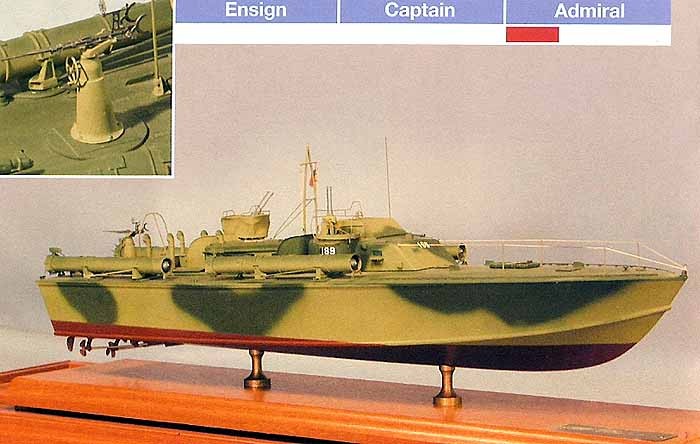
80 Ft. Elco PT Boat by Bluejacket
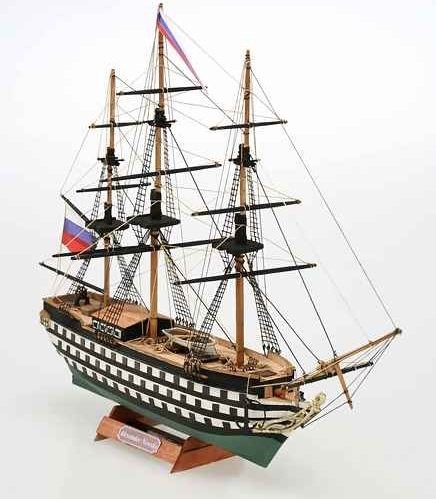
Alexander Newsky

Alfred by BlueJacket

Antares Cutter Yacht by Krick
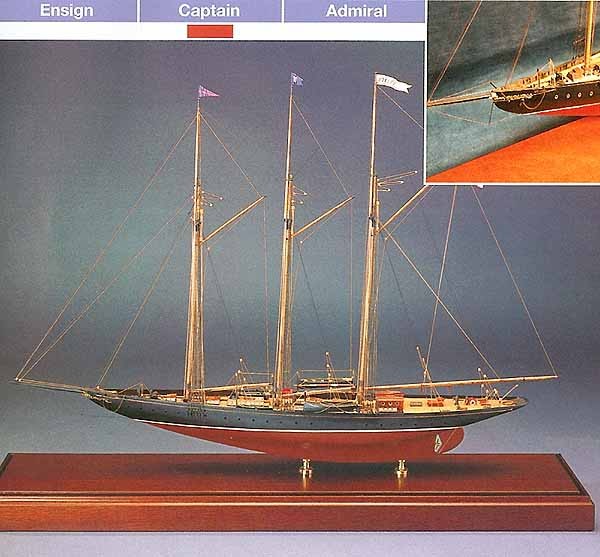
Atlantic by Bluejacket

Constellation by Amati

CSS Virginia by Bluejacket
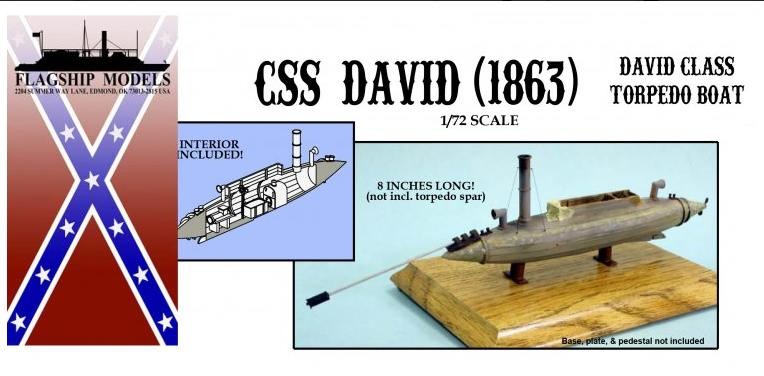
David Torpedo by Flagship Models

Elizabethan Galleon First Step by Amati
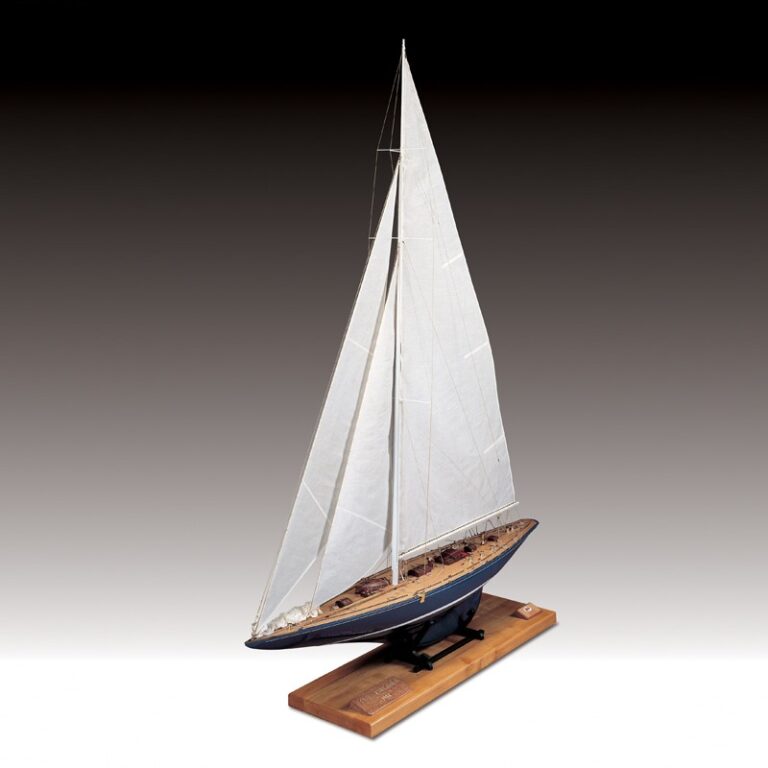
Endeavour J Class by Amati

Fannie A. Gorham by Bluejacket
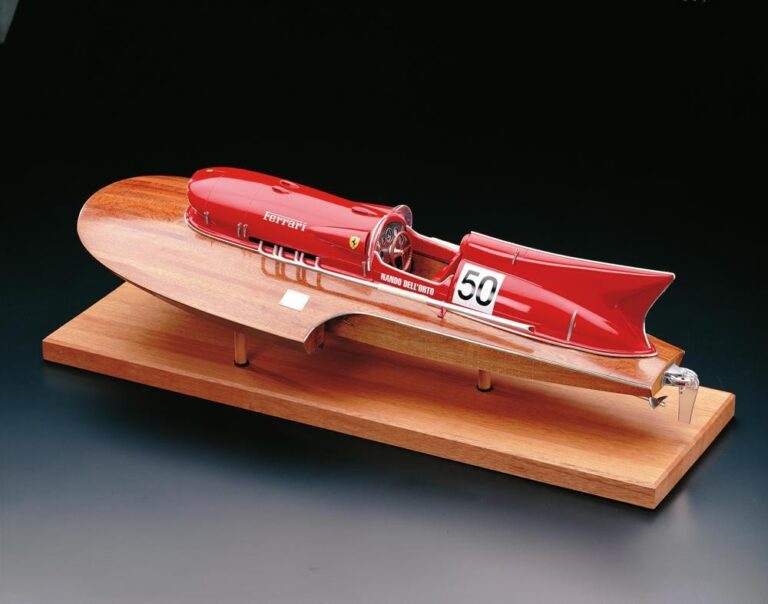
Ferrari Arno XI LE by Amati
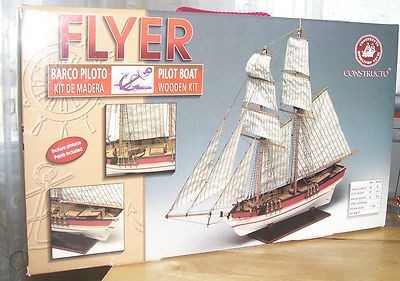
Flyer by Constructo

Golden Hind 1:110 Scale

Goletta Elisabeth

Gozzo De Pesca 1:28 Scale
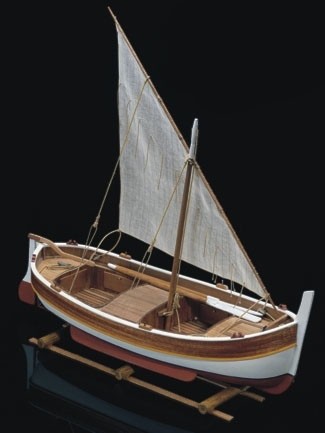
Gozzo Vela 1:28 Scale

HMS Bounty First Step by Amati

Hobie Cat by Artesania Latina

Il Relitto (1:300 Scale)

J.S. Elcano by Constructo
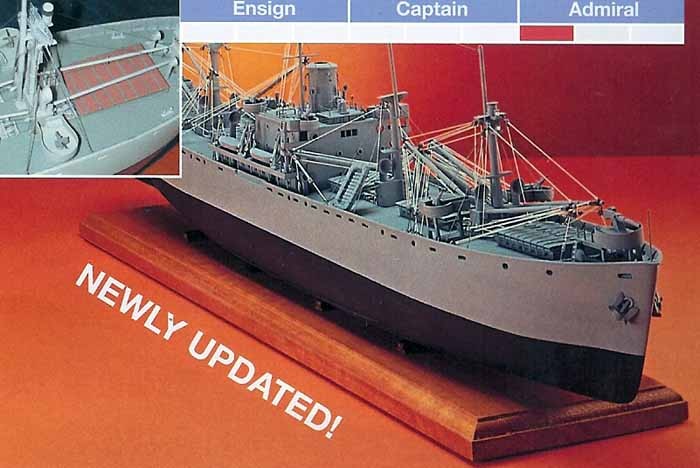
Jeremiah O’Brien by Bluejacket
Assembling the ship starts with the hull, the main body of the ship. The hull is usually made up of several small pieces that need to be glued together. It is important to follow the instructions and use the recommended glue to ensure a strong bond. Once the hull is complete, the next step is to add the decks, masts, and rigging. These pieces may be made of wood, metal, or plastic and will also need to be carefully glued together and attached to the hull.
The final step in building a solid hull model ship is to paint and detail the model. This is where the use of various paintbrush sizes and colors comes into play. The level of detail and accuracy in the painting can greatly enhance the overall appearance of the ship. Some kits may also include decals or stickers for added details.
In addition to the tools and glue, the materials provided in the kit are crucial in building a solid hull model ship. These materials may include wooden sheets, metal pieces, rigging, and other small parts. It is important to handle these materials with care and to keep them organized to prevent any loss or damage.
Overall, building a solid hull model ship requires time, patience, and attention to detail. It is a process that can be both challenging and enjoyable. With the proper tools, glue, plans, and materials, a model ship builder can create a beautiful and accurate representation of a traditional sailing vessel.
Refastening a Wooden Hull - Season 4, Episode 1 Now Available!
Wood Selection: Choosing Boat Lumber

The original print version of this quide can be viewed as a PDF or purchased from the WoodenBoat Store.
W ooden boat building is different from any other form of woodworking. It requires curves and angles rarely found in furniture and house construction. Boats are structures that move. Because a boat spends much of its life in water, the wood used to build it must have certain properties that give it sufficient strength, make it resistant to rot, and provide resiliency when used in conjunction with fastenings, adhesives, and day-to-day use. So, as you begin to look at boatbuilding wood, there are certain things you’ll need to know.
In this issue of Getting Started, we’ll examine important characteristics of wood, look at some of the wood species and plywood types used in boatbuilding, and give you some pointers on how to create a stock list. This article is limited to wood selection, so you won’t see processes such as milling, machining, or working wood covered here. This overview, we hope, will help you select the best material for your project and help you to get the most out of every board foot.
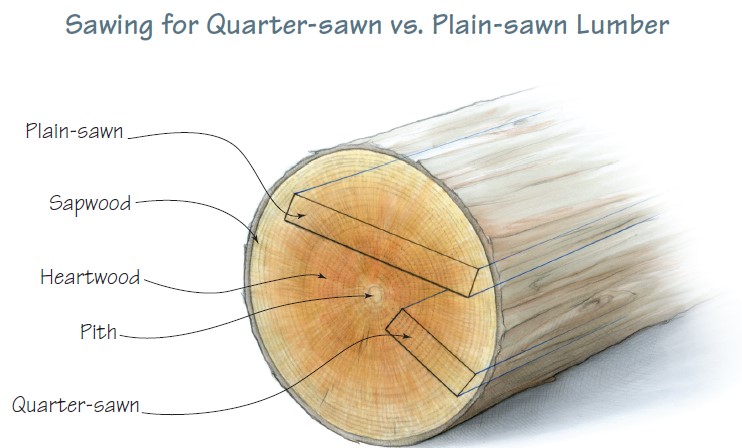
Wood Basics
W hen selecting wood, it’s important to consider dimensional stability. Dimensional stability refers to how much a board shrinks or swells. One way that sawyers can help assure some level of dimensional stability is by taking cuts in the log that best utilize its growth-ring pattern for minimizing shrinkage and swelling.
What to Look for in Boat Lumber
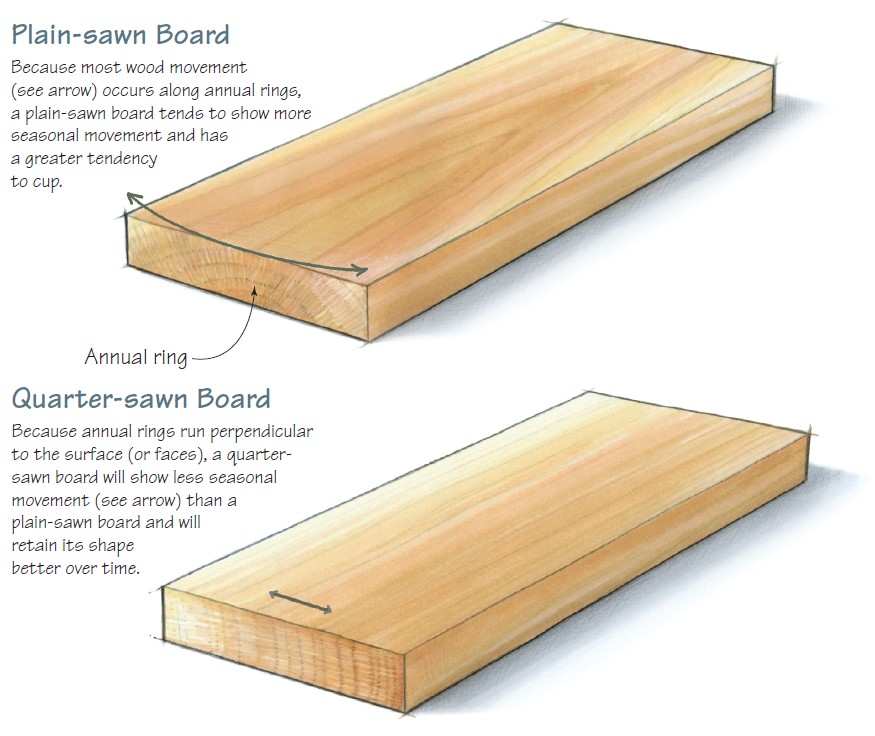
Quarter-sawn lumber will have good dimensional stability across its face. It is usually considered the prime cut and, as such, costs more than the other cuts. Plain-sawn (or flatsawn) wood will have a tendency to cup and, over time, it will appear as if growth rings are trying to flatten out. Quarter-sawn wood is good to have in some boatbuilding applications, such as planking below the waterline, where swings in shrinkage and swelling are greater than they are on the remainder of the hull. Plain-sawn wood is suitable for planking and other components in small boats. Heartwood (the older part of the tree) is often more durable than sapwood (the outer rings in the living tree). Sapwood of any species is considered non-durable. Some boatbuilders shy away from using sapwood, others do not. Personally, I am less inclined to use it unless I can place it well above the waterline.
More Terminology
H ere are some characteristics and terms commonly used when dealing with boatbuilding lumber; the first four have to do with warping.
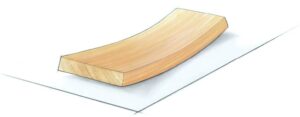
Bow—Curve along the face of a board from end to end, like a rocker at the base of a rocking chair.
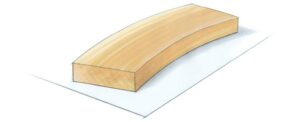
Crook—The end-to-end curve (warp) along a board’s edge. Not to be confused with this form of warp is the term crook timber, also known as compass timber (and often referred to as “a crook”), which is sawn from the roots and branch crotches of trees. The natural curvature of crook timber makes strong and beautiful stems, breasthooks, and quarter knees.
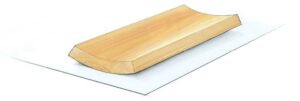
Cup or Cupping—Curve along the width of a board from side to side. Cupping is the result of uneven drying. Using even slightly cupped wood on a table saw heightens the danger of the operation because it can lead to a pinched blade and kick-back. If cupped wood must be used, I favor cutting with a bandsaw, as it is less likely to cause harm. When cutting cupped wood on a bandsaw, be sure to place the board cupped-side-down on the worktable (as a frown) for better stability while you work.
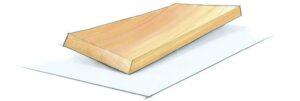
Twist—An uneven warping that makes the board appear to be spiraling. This defect is a dangerous one to mill, a difficult one to correct, and should be avoided if possible.
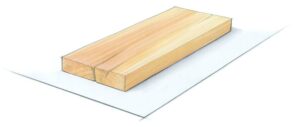
Checks or Checking—Cracks in the wood, usually found at board ends and sometimes found in the middle of the board. Checking can be a result of uneven drying, living tree shakes, or mishandling (dropping). Look carefully at boards that have checks. While checks may appear to be only a few inches long (and many are), they might indicate a major weakness along the board’s length.
Pitch Pocket—A pitch pocket is an opening between the growth rings that now holds, or did hold, resin.
Live Knot— Live knots (also known as tight or red knots) are so named because they were alive when the tree was harvested. They are more firmly attached to the board than dead knots. Since they usually are not rotten, they can sometimes be left alone rather than drilled out and plugged.
Dead Knot, Loose Knot, Black Knot— Dead, loose, or black knots are from a branch that was dead at the time of harvest. These are dark, rotten, and usually loose or easy to loosen and should be removed. They’ll leave a dark hole that should be reamed free of residue and then plugged.
Four-quarter (4/4)—A way of describing stock according to the number of “quarters” or quarter-inches in its thickness. Boards that are 1″ thick are referred to as four-quarter (4/4) stock. Five-quarter (5/4) stock is 11⁄4″ thick; six-quarter (6/4) stock is 1 1⁄2″ thick; eight-quarter (8/4) lumber is 2″ thick. Expect these to be rough-sawn dimensions, especially if wood is purchased from a lumberyard. Finished wood denoted as 4/4 will actually be somewhat thinner than an inch. So, if you need wood that is truly 1″ thick, you’ll need to buy rough stock that is 5/4.
Rough or Rough-sawn Lumber—Wood that has not yet been planed to finished thickness.
Finished Thickness—Wood that has been planed to its final thickness and is ready for the project at hand.
Wood Species
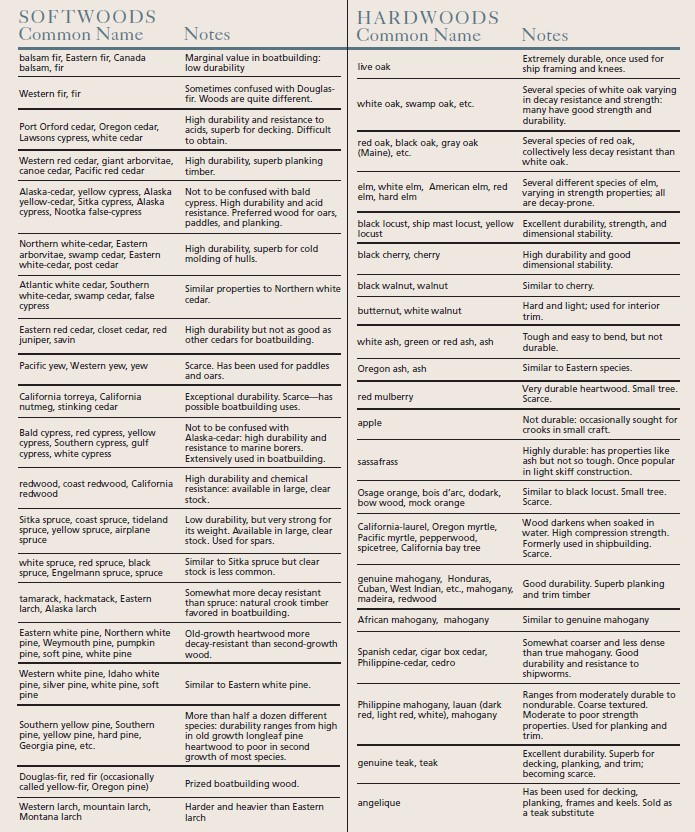
D r. Richard Jagels, professor of forest biology at the University of Maine in Orono and a regular contributor to WoodenBoat , prepared the following list of wood species that are often used in boatbuilding. It should be noted that the advent of strip-building has opened new frontiers to small-boat builders. Often used to construct canoes and kayaks, this process usually includes gluing together long, thin strips of wood on a mold into a hull shape and then encapsulating it with fiberglass cloth and epoxy. Woods such as walnut, basswood, and a variety of other species that are not traditionally thought of as boatbuilding (or at least hull-building) woods are now regularly used for strip-planking. They offer new options and color choices for small-boat construction.
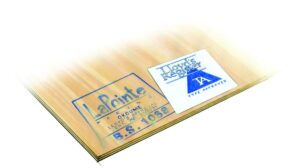
P lywood continues to gain in popularity among boatbuilders, especially those who build small boats. Chief among the reasons are its dimensional stability and its availability. It is also becoming increasingly difficult to find natural wood that is wide enough for some planking. For example, in building a traditional skiff, it is not uncommon to need a 14″ – wide board for the garboard (lowermost) strake. Also, plywood is more split-resistant, often outperforming even a properly steamed natural plank.
Some plywood is not suitable for use in a marine environment. To assure that yours is, you’ll need to look at its rating.
One basic classification to look for is B.S. 1088. The B.S. stands for “British Standard”—an acknowledged standard-setting entity. The “1088” is their best-known designation for marine plywood that is suitable for small-boat and pleasure-boat building. It is manufactured with waterproof glue and has a very limited number of small voids. An additional assurance that your plywood meets these standards comes from Lloyd’s Register. The Lloyd’s sticker on the sheet indicates that, in addition to meeting the British Standard, the manufacturers have placed themselves under the scrutiny of Lloyd’s and have agreed to meet with their standards. B.S. 1088 with the Lloyd’s sticker is more costly than the rest—but many builders feel that it’s worth it. When you consider how little the cost of materials is in the scheme of building a boat (time in labor is the greatest expense), I would agree with them. When you shop for plywood, make sure that it meets B.S. 1088 or a comparable standard.
Another factor to consider is the boat’s intended use. Our technical projects manager and resident boatbuilder here at WoodenBoat, Tom Hill, says, “When I build a small boat that needs to be lightweight but can be stored in a garage, I use okoume. It is easy to work and it takes paint well. When weight is less of a concern and I need the boat to be highly rot and abrasion resistant, like when I’m building for an owner who plans to moor his boat all season, then I’ll use sapele.”
When looking for marine plywood, it’s important to ask questions. Reputable dealers will help you, even if you don’t wind up buying from them. To learn more about marine plywood, I encourage you to read Chris Kulczycki’s article on the subject in WB No. 174.
Calculating Board Footage
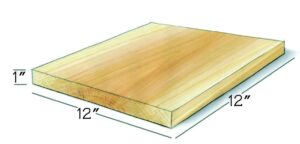
B oard feet” is a way to express lumber volume. One board foot is equal to 144 cubic inches of wood. To find board footage of an amount of wood, we multiply the thickness (in inches) x the width (in inches) x the length (in inches) and divide it by 144 .
So, for our 1 BF we have: 1″ x 12″ x 12″ = 144 cubic inches 144 cubic inches /144 = 1 BF
Now let’s look at a more complex scenario. Here we have a board that is 2″ thick x 12″ wide x 8′ long. First, let’s convert the length measurement into inches. Now we have: 2″ x 12″ x (8′ x 12″ [per foot]) = 2,304 cubic inches then 2, 304 cubic inches /144 = 16 BF
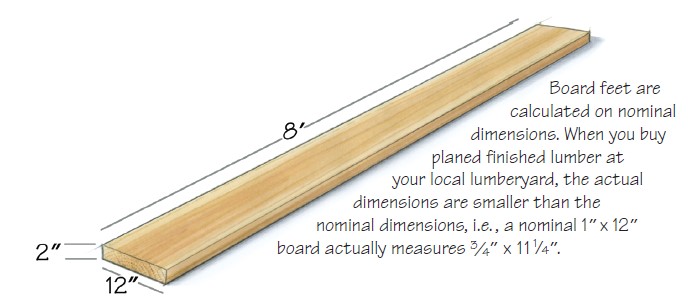
Making a Stock List
W hether you plan to purchase your wood or go out and harvest it yourself, it’s a good idea to begin your planning by making a stock list (aka: cut list). It may take some time, but in the long run having an accurate stock list will be a big help in estimating costs, and it will guide you in your selection of stock.
The chart has spaces for the individual pieces, the number of pieces needed, their finished dimensions, rough dimensions, wood type (species or plywood type), comments (such as notes or sources), and board feet (BF). You can easily make a chart by hand or on your computer, or you can download one from our web site <www. woodenboat.com> (click on “Getting Started in Boats”).
Begin by looking at your plan. List the names of each piece in the stock list. Some people like to list items according to their building sequence. I prefer to list them according to wood species used. Then, put in the finished dimensions of each piece. Depending upon the level of detail given in your plan, you may need to do some “guesstimating.”
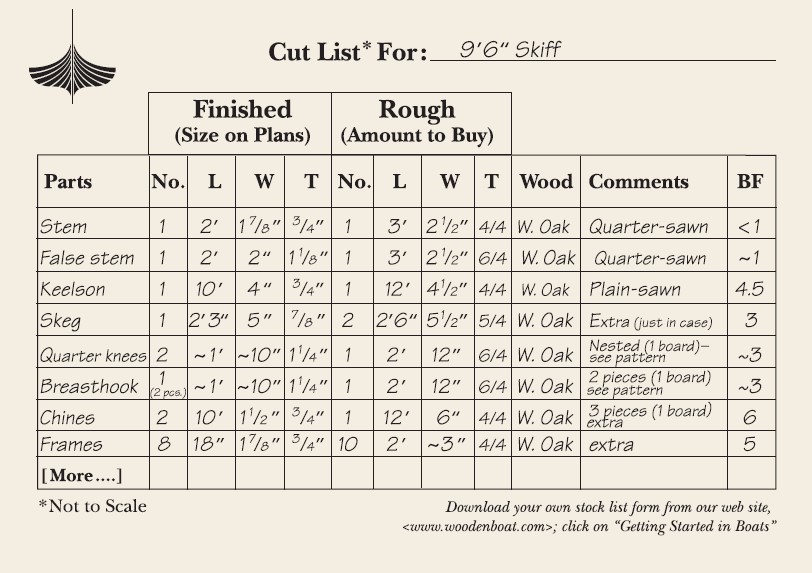
Details such as finished plank lengths can be difficult to pick up from the plan since they are either foreshortened or don’t go in a straight line in every view. Planking presents other special challenges, too. The forward part of the plank may be wider than the aft section. This is often the case with the garboard plank on a traditional skiff. This type of plank may be built out of two boards of different widths. If you choose to do this, make a note of it on the stock list and account for the added length that will be needed to join the two boards together with a scarf joint (a long, tapered joint between two long pieces of wood). Once you have determined the overall finished lengths of your planks and plank pieces, add two to three feet to the overall hull length (rough dimensions) to allow for bending and clamping. Do the same for other long components.
Also note which pieces, such as quarter knees, can be nested (almost like interlocking pieces) or configured around a knot and cut from the same board. I find it helpful to make a sketch of how these could be laid out and what type of board and grain pattern is best.
Finally, in tallying your stock list, you’ll need to add extra BF to account for waste and defects. Are you sitting down? For planking, especially if your stock is live-edged (with the bark still on it), has sapwood, and a lot of defects, plan on over-buying by as much as 100%. For other pieces, plan on buying 30–50% more wood than you think you’ll need.
Locating and Storing Wood
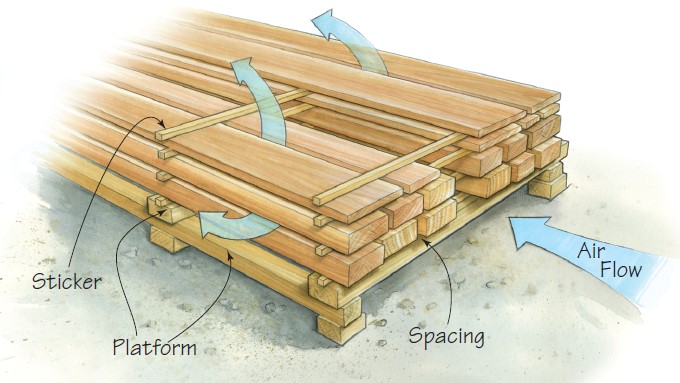
Locating wood—Finding wood for boatbuilding can be a challenge, especially for people who live far from where it is harvested. Unlike the species needed for house construction or furniture making, boatbuilding woods are rarely carried by lumberyards. Get to know a local sawyer, if possible. Lumberyards and big-box stores can be a good place to buy interior or exterior grade plywood (non-marine use), or medium- density fiberboard (MDF) for building jigs and molds. Occasionally, you can even find wood for components like thwarts.
Finally, I’d be remiss if I didn’t mention that one excellent source for locating boatbuilding wood and specialty lumberyards is the classified ad section of the magazine you are now reading.
Storage—The cover photograph for this issue of Getting Started shows how we store white cedar planking stock at WoodenBoat School here in Brooklin. This idea came to us from Harry Bryan, a popular instructor at the WoodenBoat School and a contributing editor to this magazine. While a practical and ingenious idea, most people don’t have the room or the need for this much lumber. The illustration above depicts a method that will work for just about anyone.
Distribute your lumber by weight. Place the largest, thickest pieces at the bottom of the stack. Don’t forget to place stickers under the bottom-most pieces. Make sure that there is at least a finger’s-worth of space between boards that are placed next to one another. Follow this procedure as you place each (progressively lighter) layer of wood on the stack.
Whether your wood is home-harvested or an online purchase, the quest to find boatbuilding lumber shouldn’t feel like a trip to the woodshed. We hope that we have provided you with some new insights so that you’ll know what to look for (and look out for) when selecting wood for your next project.
Karen Wales is associate editor of WoodenBoat. She thanks Dick Jagels for his contributions to this article.
Further reading: Considered the preeminent source in the United States, “Wood Handbook: Wood as an Engineering Material” from the USDA Forest Products Laboratory in Madison, Wisconsin.
Building Beach Pea, Part 1
The joggle stick, painting symra, laminating knees and frames for small craft, subscribe for full access.
Flipbooks are available to paid subscribers only. Subscribe now or log in for access.

- Furniture Delivery
- Your Shopping Experience
- About DutchCrafters
- Business Sales
- Frequently Asked Questions
- Learning Center
Video Library
Timber to table blog.
- Customer Testimonials
- Shop the Look
- Shop by Style
- Visitor ID:
- Order Tracking
DutchCrafters Amish Furniture
Welcome to the largest amish furniture collection online.
Shop DutchCrafters and you receive more than just your dream furniture built to your customizations. You join a movement that rejects big box store discardable furniture for furniture that is good for the earth, good for America, and good for you. Since 2003, DutchCrafters has been the pioneer in connecting people with authentic Amish furniture that lasts for decades, is made of regionally harvested hardwood, and supports American small businesses.
- Largest Amish Furniture Collection
- Made in America
- Flat-Rate Shipping on Most Products
- Solid Wood Construction
- More Than 20 Years of Expertise
- Customizable
What Customers are Saying

Get Inspired
Want the Showroom Experience?
Visit one of our destination showrooms for hands-on experience with our Amish and American made, solid wood furniture. Our friendly furniture specialists and interior decorations will help you design your furniture in the style you love with the wood, finish and upholstery options just right for you.
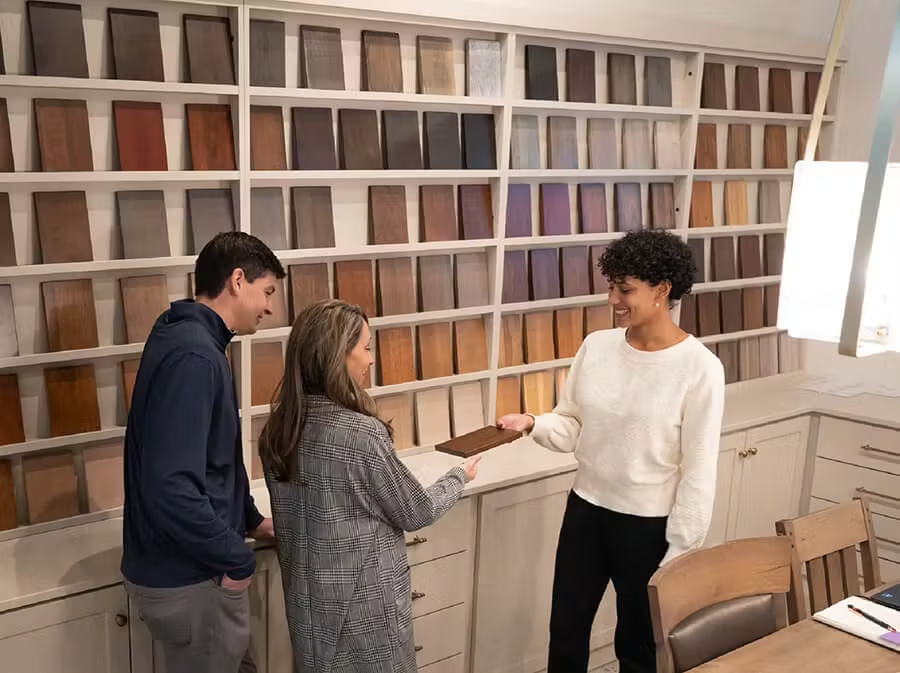
See our heirloom quality Amish furniture for yourself through our up-close-and-personal videos. From customer reviews to product highlights to How Tos, our videos give you a better view of our American made furniture.
Get inspired with ideas we’ve gathered through the years as the expert retailer of American-made Amish furniture. Our blog offers interior design advice, Amish recipes, and tips to help you create a life you love.

The Learning Center
Learn about the Amish, furniture collections, wood types and finishes, and much more. The Learning Center is your home for design ideas, style tips, and buying guides, all in one place. Start your shopping experience here.

Model Boat Hull Construction
The carved block method, part one. model boat hull construction made easy – a step-by-step instruction how to build a wooden boat model hull from a solid block. the method described is common for ship model kits and scratch building..
Building a model boat hull using the carved solid block method can seem intimidating at first. It shouldn’t be though - if being methodical there is no reason a first attempt will not turn out as good as any.
The carved block model boat hull construction is best used for:
- Static ship models - up to 600mm (24 inches) long
- Making a pattern for resin or fiberglass hulls
- Making ship's boats ("life boats")
This method has disadvantages, such as:
- Hulls may crack - The risk is increased with large cross sections and the use of inproperly seasoned lumber.
- Limited use if natural wood finish is desired. This would require planking after the carving process is completed.
You'll need:
- A hull plan in the right scale with deck plan, profile and cross sections. It helps if the stations (where the cross sections are located along the hull) are marked on the other two views.
- A piece of wood as described below.
- Hand Tools: Carving tools, files, sandpaper. Hand plane if you are prepping your own wood block. A hand saw* of some kind to roughly shape the ends of the wood block.
- Drafting tools: Pencil, square and scale.
- Also helpful tools: A bandsaw is a good help, but not essential. *If you have access to one, you won't need the hand saw above.
Step 1: Select Model Boat Hull Material
Most model ship hulls built with this methods are made from either mahogany or basswood (linden in Europe), but there are many other suitable wood species, such as poplar and alder. For beginners, I’d recommend basswood or poplar because they are easy to carve and inexpensive.
For experienced woodworkers there is no reason cherry or walnut could not be used. If you have a favorite wood or a perfect scrap piece, you may as well use it.
The type of wood can always be negotiated as long as it is stable . I find it more important to select properly seasoned lumber, free of knots and pitch pockets.
Lumber I wouldn't use include oak, American beech, birch, hard maple, and exotic species like rosewood, teak, purpleheart and bloodwood. These species are hard to work with hand tools and dull edges quickly when carving.
This method is best used for models under two feet in length and under 6-8 inches wide. This off course is a loose rule that will vary with ship type etc. If you want to go bigger, consider the bread-and-butter method (also known as the laminated method) for saving in material and weight.
Step 2: Preparing the Wooden Block
Make sure the block is squared up, i.e. the long sides are square and parallel to each other and that the block is a quarter to half an inch longer than the finished hull (6-12mm).
With a pencil, mark a centerline down the middle of the block. An alternative way to achieve this is by gluing up two boards where the joint will become the center line. This works great as long as the boards are straight, without twist and properly surfaced before gluing.
Step 3: Mark the Stations, Profile and Deck outline
With a square to guide you, measure out and mark the stations. Photocopy or trace out the profile and deck outline onto separate pieces of paper. Cut them out with scissors to form templates.
Line up the deck template symmetrically on the centerline and align with the stations. Trace the deck outline with a pencil onto the block. Follow the same method for the profile template.
Step 4: Cut out Profile and Deck outline
A band saw will make your life a lot easier in this step, but are not essential. Begin by cutting out the profile. Then cut the deck outline.
Then cut the deck outline. Notice how the stations you so carefully marked got cut away. Use the square and pencil them in again.
Step 5: Make Station Templates
These are best made by photocopying or printing out the body sections onto card stock and then carefully cutting out with an X-acto knife.
Be sure to mark the water line and deck line. By making the template upper edge level with the deck line, you'll kill two birds with one stone. It’s also a good idea to put the station number on each so you can identify them easier.
Continue the Article Series Below
Part Two - shaping the hull and deck
Part Three - fitting keel, stem, sternpost and rudder
Part Four - planking the deck and fitting gunwales
Return from Carved Model Boat Hull to Hull Design
Return to Homepage
| Facebook Twitter |
Would you prefer to share this page with others by linking to it?
- Click on the HTML link code below.
- Copy and paste it, adding a note of your own, into your blog, a Web page, forums, a blog comment, your Facebook account, or anywhere that someone would find this page valuable.
- Plans Store
- Model Boat Books
- Model Boats Intro
- Building Materials
- Make a Hull
- Plastic Kits
Radio Control
- US Battleships
- Torpedo Boats
- Model Boats Q&A
- Model Ship Gallery
- What's New?
- Privacy Policy

By Petter Blix
Copyright 2009-2018 Building-Model-Boats.com
Trademarks belong to their respective owners
All Rights Reserved

IMAGES
VIDEO
COMMENTS
Get ready for hours of fun with this classic game! The Yacht Game Solid Wood set is perfect for players of all ages, from 4 to 100. With a brand name of GAME, you know you're getting quality and durability that will last for years to come. This complete game includes everything you need to play, including dice and score sheets.
Yacht Game Solid Wood - Ages 6+ - Yacht + 4 more games - NIB. Includes five 2" wooden dice, score pad & instructions. In addition to Yacht, these dice games and others can also be played Farley, Pig, Left Center Right and Bug. See instructions inside. Please view our other items available…will combine shipping at a very reasonable discount…just added weight and we are always listing many ...
Includes five 2" wooden dice, score pad & instructions.
Yacht Game Solid Wood Ages 6+. ... Something went wrong. View cart for details.
Prepare your sea legs for a challenging two-player voyage. This tabletop balance game promises fun for all ages as players try to keep on an even keel, moving passengers safely from the deck to their cabin. Interchangeable rockers of differing sizes vary game playâ€"large rockers provide more stability, and smaller ones demand more finesse. Built-in storage makes the game easy to stow away ...
View this item and discover similar for sale at 1stDibs - Made by the Parisian luxury furniture company 'Starbay,' which specialized in 'mobilier de marine,' this game exotic wood parquetry game table stands on
Either way, this game is tons of fun to play! In this blog, we'll go over the basic rules on how to play Yacht, as well as some strategies to help out the newer players. Continue reading to learn some of the rules that you'll have to know in order to succeed. Rules of The Yacht Dice Game. It can be intimidating to start playing the Yacht.
PREMIUM QUALITY MATERIAL: Our wooden craps dice boat is made from heavy-duty solid wood that is extremely durable, tough, dense, well-constructed, and smooth to the touch to ensure long-term use. WOODEN DICE BOAT: The surface of the dice boat is a polished finish, no sharp edges, preventing the table from being scratched. Dice is not included.
UGEARS Rescue Hovercraft - Boat Model Kits for Adults - 3D Wooden Puzzle Ship - Wood Model Boat Kits to Build - Premium Model Boats Kits with Intricate Design to Build for Adults $54.99 $ 54 . 99 Get it as soon as Monday, Sep 9
Our Jumbo hi-tower brings the classic block stacking game to life in a supersized way. Crafted from sustainable pine wood, this set boasts 58 smooth, solid blocks that build a towering structure starting at 0.6 meters and reaching an impressive 1.56 meters in play! Challenge friends and family of all ages to take turns carefully removing blocks without toppling the precarious tower.
Best with 2 to 5 players. 5 six-sided dice, along with pencil and paper to keep score. To score more points than your opponents by rolling certain combinations of numbers. Create a score sheet with 12 rows and a column for each player. Label the rows as follows: Yacht: Five of the same number (e.g. 4-4-4-4-4).
Dumas # dum1706. This is the 12-1/2'' 1935 Chris Craft 25' Steamline Cruiser Laser Cut Kit (1/24) Wooden Boat Model Kit by Dumas. Hobbylinc carries 11 solid wooden boat model kits at discounts up to 26%. The most popular solid wooden boat model kits brands include Dumas, Woodkrafter Kits, and Model Shipways.
So the question "is it possible to make a 10,000 kg fin-keel boat with a 2m keel survive an 8-knot hard grounding on solid rock" is reduced to "is it possible to share 19 tonnes of tension among the first few keel bolts, and carry 14 tonnes of compression from the trailing edge of the keel joint into the hull, plus appropriate safety ...
1 Moonglow Bay. Lastly, we have Moonglow Bay. This game is a bit different than the other entries on our list. Rather than sailing on the open seas, you will sail around the town of Moonglow Bay collecting different fish and completing quests. As you progress, you can upgrade your ship to become more efficient.
Brilliant Skies. From the Depths is one of the most extensive ship-building games on the market, with an incredibly deep and detailed building and physics system. Players can create various ...
Play Yacht, the classic dice game also known as Yahtzee or Yatzy, with friends on Bloob.io. Roll, score, and win together! You can join a (private) match by filling in the four-digit ID. You have received an official account warning. Multiple warnings will result in more severe punishments. English (US)
The process of building a Solid Hull Kits can be both challenging and rewarding. It requires patience, attention to detail, and the use of various tools, glue, plans, and materials. The first step in building a solid hull model ship is to carefully study the plans included in the kit. These plans will serve as a guide throughout the building ...
W ooden boat building is different from any other form of woodworking. It requires curves and angles rarely found in furniture and house construction. Boats are structures that move. Because a boat spends much of its life in water, the wood used to build it must have certain properties that give it sufficient strength, make it resistant to rot, and provide resiliency when used in conjunction ...
Yacht is played with five six-sided dice. Yacht [1] is a public domain dice game, similar to the Latin American game Generala, the English game of Poker Dice, the Scandinavian Yatzy, and Cheerio. [2] Yacht dates back to at least 1938, and is a contemporary of the similar three-dice game Crag. [1] Yahtzee is a later development, similar to Yacht in both name and content.
of solid wood Amish furniture products online. Furniture Specialists. are available to help you customize your order. Call 941-867-2233. Free Stain Samples (when returned within 30 days) help you find the perfect finish. Only 40% Down. to start your order on qualifying purchases over $2,000.
Horse Race Board Game Racing Game Thickened Solid Wood with 11 Luxurious Durable Classic Metal Horses with 4 Dice and 2 Boxes of Cards Horse Racing Game (Log Color, Rectangle) Visit the Jyquorp Store. 4.7 4.7 out of 5 stars 365 ratings | Search this page . 600+ bought in past month.
The carved block model boat hull construction is best used for: Static ship models - up to 600mm (24 inches) long. Making a pattern for resin or fiberglass hulls. Making ship's boats ("life boats") This method has disadvantages, such as: Hulls may crack - The risk is increased with large cross sections and the use of inproperly seasoned lumber.